On Sunday morning I was up in plenty of time to catch breakfast once more. I had places to go! And a bus to catch at 10am, so I was seated in the restaurant by 8.30am. And I managed to get some sneaky pics to give you a better idea of the spread on offer!
Fruit and pastries…
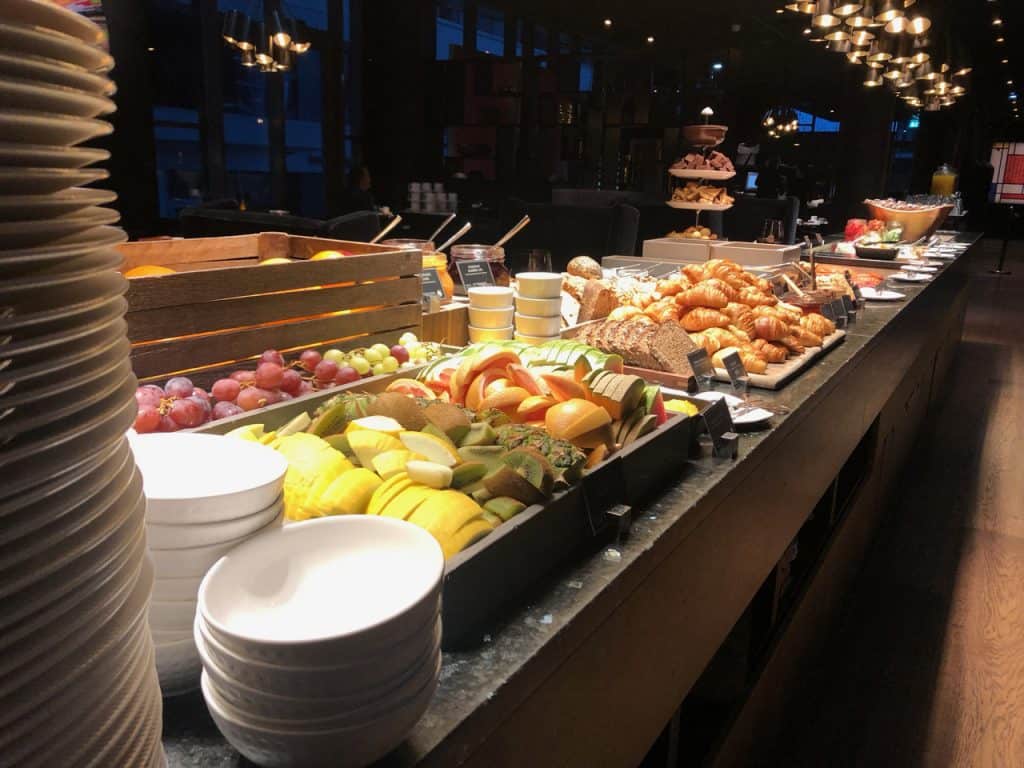
Butter, hams (note the reindeer salami at the back) and smoked salmon….
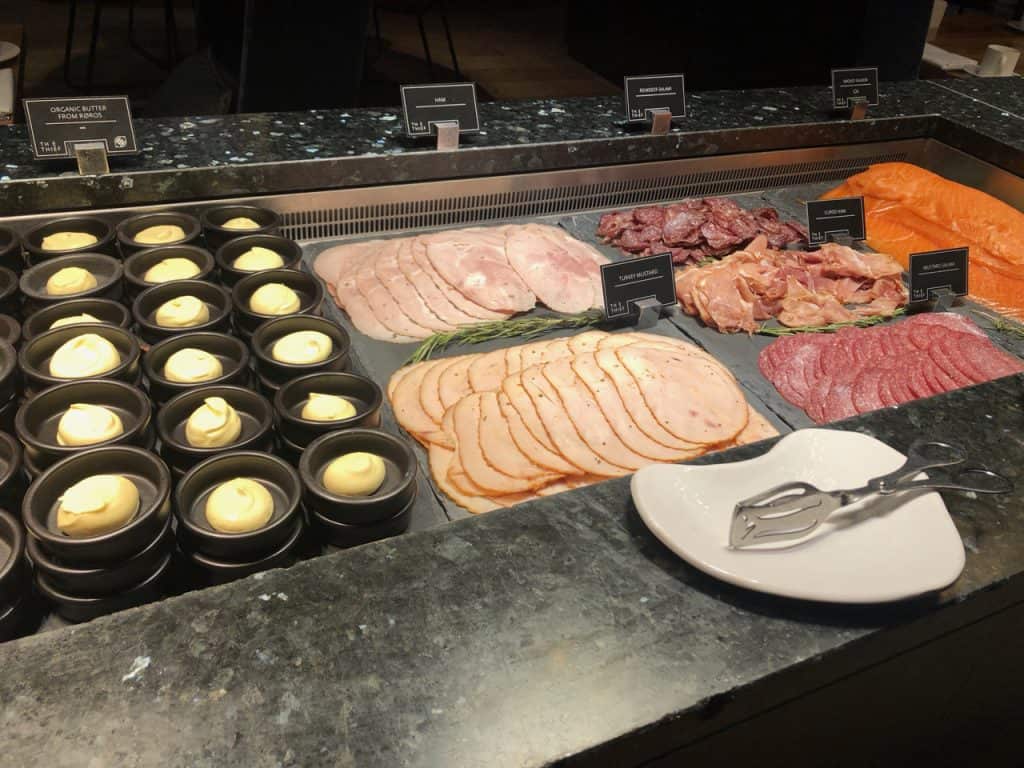
and cheese.
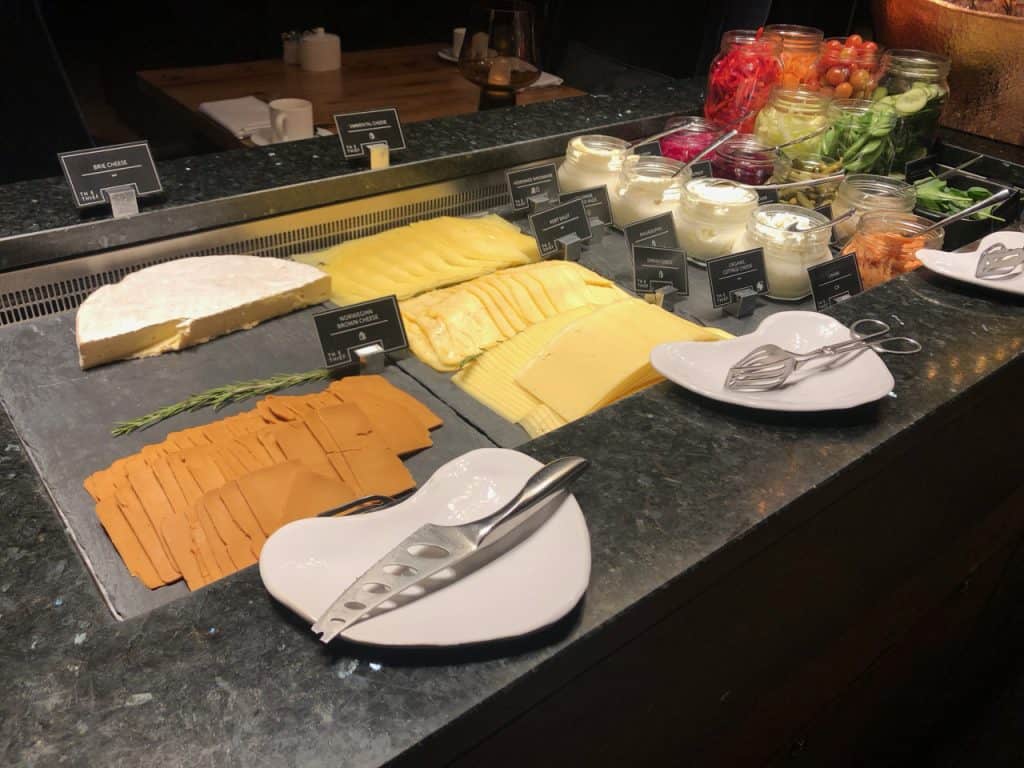
I went a bit less crazy with my breakfast this time, having a small slice of bread with a slice of ham and cheese, a bit of smoked salmon and rollmop herring (which I could happily live on for the rest of my life).
Then a smallish plate of hot food too.
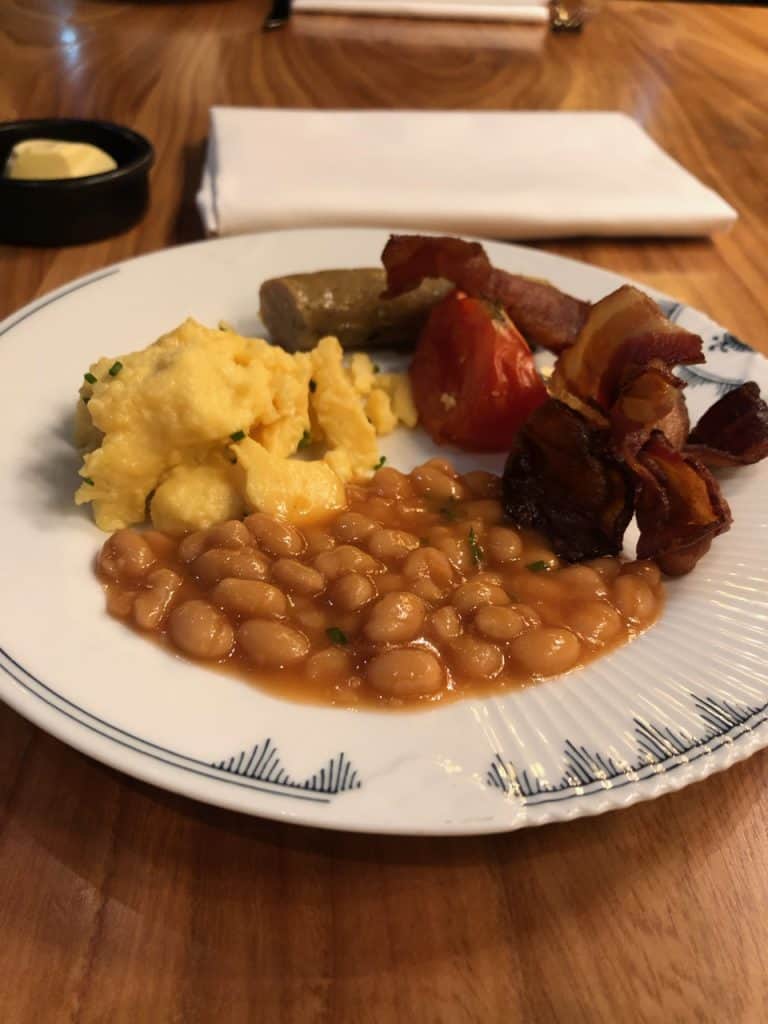
Getting an Oslo bus
After getting my stuff from my room I set out to catch the bus – walking through a wet Aker Brygge to a bus stop at the harbour, just along from the city hall.
Getting a bus in a foreign city always puts me in a little bit of a panic for some reason! There’s the whole ticket buying palava – do you do it on the bus, before you get on the bus? Then there’s the stress of making sure you don’t miss your stop when you’ve no idea where you are. Thankfully I had no reason to worry about Oslo’s bus services!
Having googled the life out of it the night before, I’d downloaded the Oslo public transport app, called RuterBillett. You can select your ticket easily in the app – just choosing what time you want it to be valid from. Then pay in the app with Apple Pay, and you’re all set.
You can see the kind of day it was in the picture below. Not too cold, but pretty wet and miserable. Thankfully I had less than ten minutes to wait before my bus – the number 30 to Bygdøy – came along.

And yes that is a no. 32 bus in the pic – that was the one that came along before mine. When the 30 turned up, the bendy bus was pretty busy, but it had screens that showed the next three stops it would be calling at and even how long it would take to get to each of them. So for me, that was perfect. I could sit back and relax! If I’d been visiting in the summer, I could have taken a ferry which no doubt would have been a more fun experience, but as it was November, I was stuck with the bus.
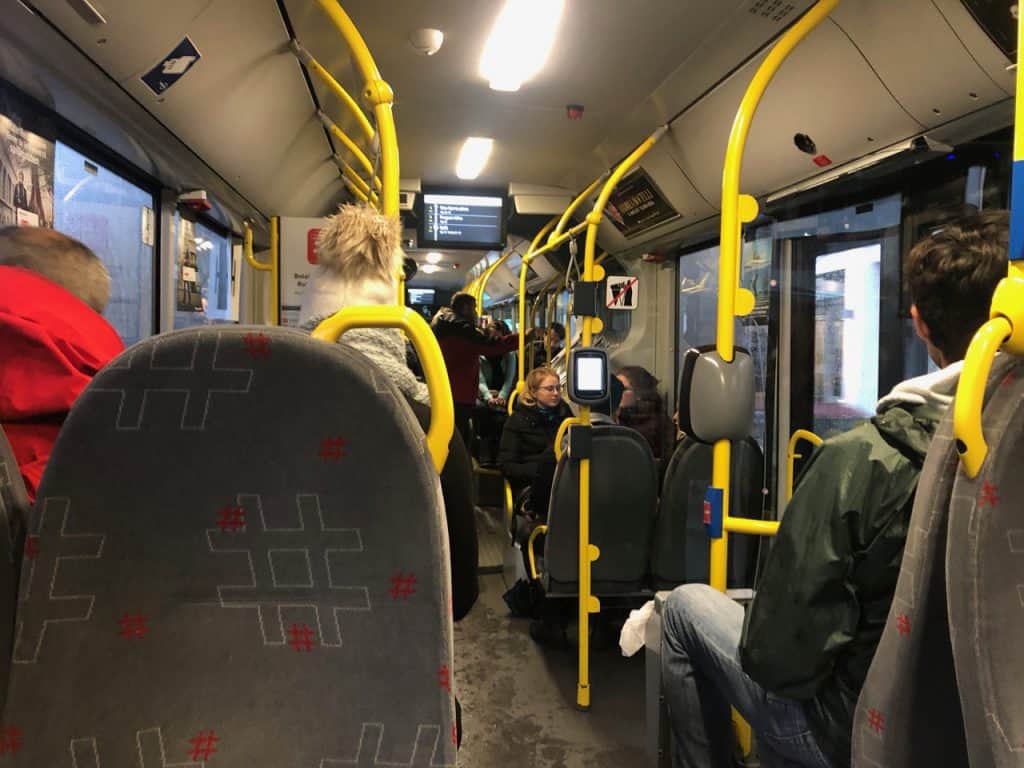
With most of Oslo’s shops closed on Sundays, I’d decided to head out to the peninsula of Bygdøy, about a twenty minute trip from the city centre. As our journey continued, buildings thinned out, offices and shops became houses, and the roads narrowed and got more bendy – meaning some tight manoeuvres for our bus driver.
Bygdøy is first and foremost a residential area, but its beaches and trails
Bygdøy museum no. 1 – The Kon-Tiki Museum
Most of the passengers got off at the bus’s last stop before it turned around to head back to Oslo’s centre. Where two museums sat opposite each other. Everyone apart from me turned right to head into the Fram Museum which is home to the strongest wooden ship ever built – one which still holds the record for sailing the furthest north and furthest south.
I however, being a rebel, turned not right and towards that museum, but left towards this place….
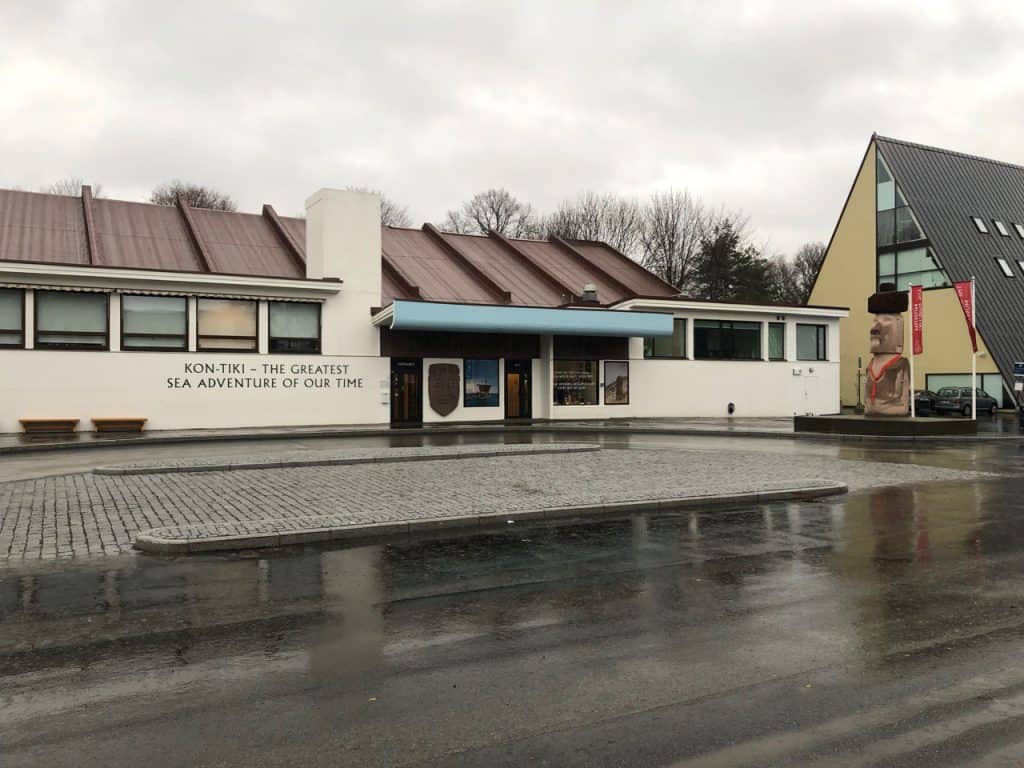
The Kon-Tiki Museum. It’s apparently loads of Norwegian kids’ favourite museum, so I thought it sounded right up my street!
I walked into the modern reception area, paid my 120 Krone admission fee (just a smidge over £11 at the time), and wandered into the exhibit area.
I’m going to confess here that I had never, ever heard of Kon-Tiki before. However most people I’ve spoken to about it since I got back to the UK knew all about it. So yes, the whole story was new to me, but without a doubt, the Kon-Tiki Museum is one of the best museums I’ve ever set foot in.
If you don’t know the story, the Kon-Tiki expedition was led by Norwegian explorer Thor Heyerdahl. He’d become convinced that the Islands of Polynesia had been colonised by people from South America more than 1500 years ago. His theory wasn’t taken seriously by experts though – nobody believed anyone could have made the 4,300 mile journey with the resources available to them at the time.

So Thor set out to prove them wrong. He decided to form a team who would join him in re-creating the journey by building a raft using the same methods and materials available to South Americans back then.
And that basically is what the museum’s about. Well that, and other expeditions Heyerdahl went on to organise.
It’s hard to sum up just why the museum’s so brilliant. But I think part of the appeal is Thor himself – a man who had an idea, really believed in it, and against all odds proved everyone else wrong. (His expedition was in the end a success). It’s such a great story with a charismatic character at the helm.
Then there’s the fact that the museum is detailed about everything, but easy to follow at the same time. They have great displays, packed with interesting items – and the actual Kon-Tiki raft that Thor and his team set sail on. Which is just brilliant – look at that!
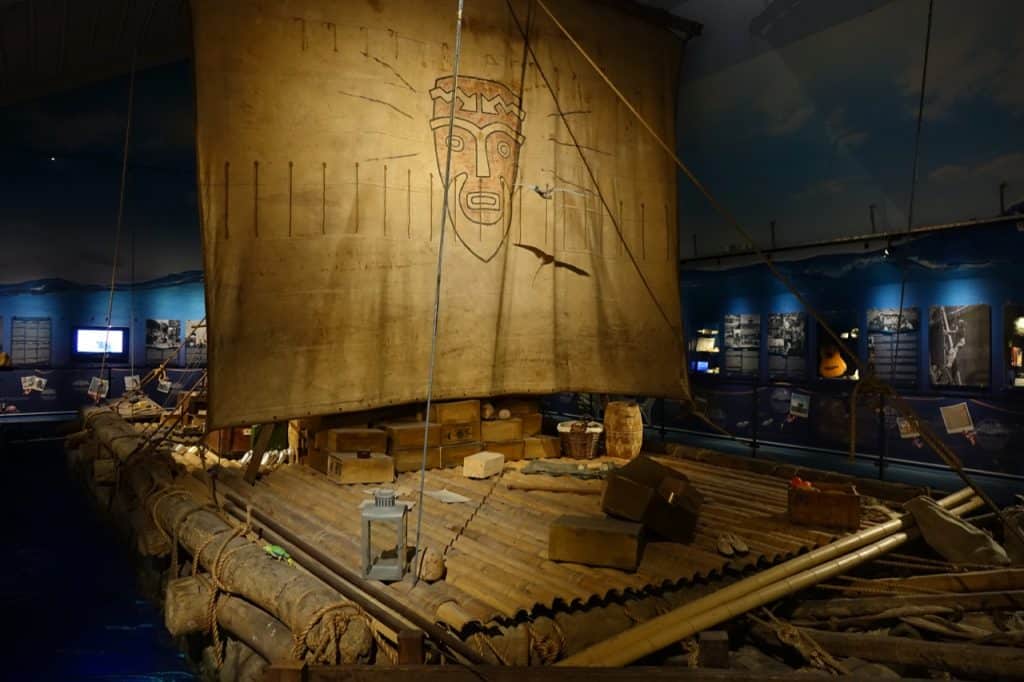
There’s a whole load of information in the museum about Easter Island too. There’s a fun little cave bit which mocks up a cave from the island…
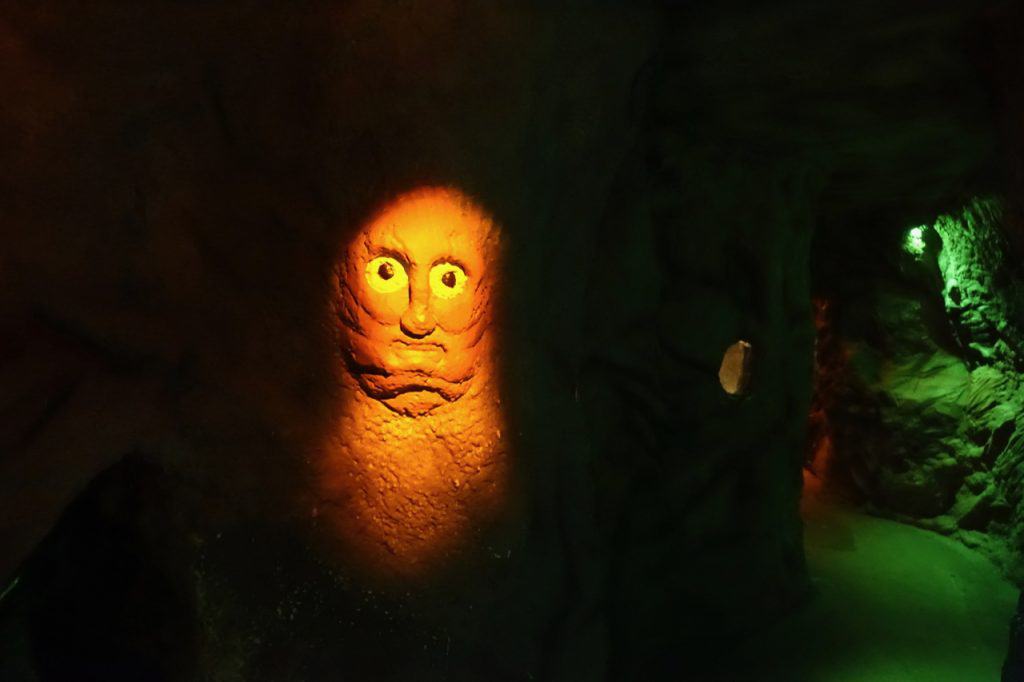
…and you can see cave stone sculptures given to Thor by the people there.
As I walked around, I was just totally engrossed – and I honestly don’t say that very often about a museum. Thor just seemed like a brilliant guy and an awesome adventurer. I loved how on another exhibition he not only took seven humans (deliberately all from different cultures) with him but also a monkey called Safi and a duck called Sinbad.
I can’t really do the museum justice here. All I can say is I absolutely loved it. Proceeds from the museum help carry on Thor’s research work which I thought was a great way to continue his legacy. It is well worth a visit if you’re in Oslo. You can read more about the place here.
After finishing walking around, I went a bit mad in the museum shop (perhaps getting a bit too wrapped up in the story 🤣). I bought a present for my nephew who I think is a keen future explorer, some Moai magnets, a book on Kon-Tiki and a cool pin as well.
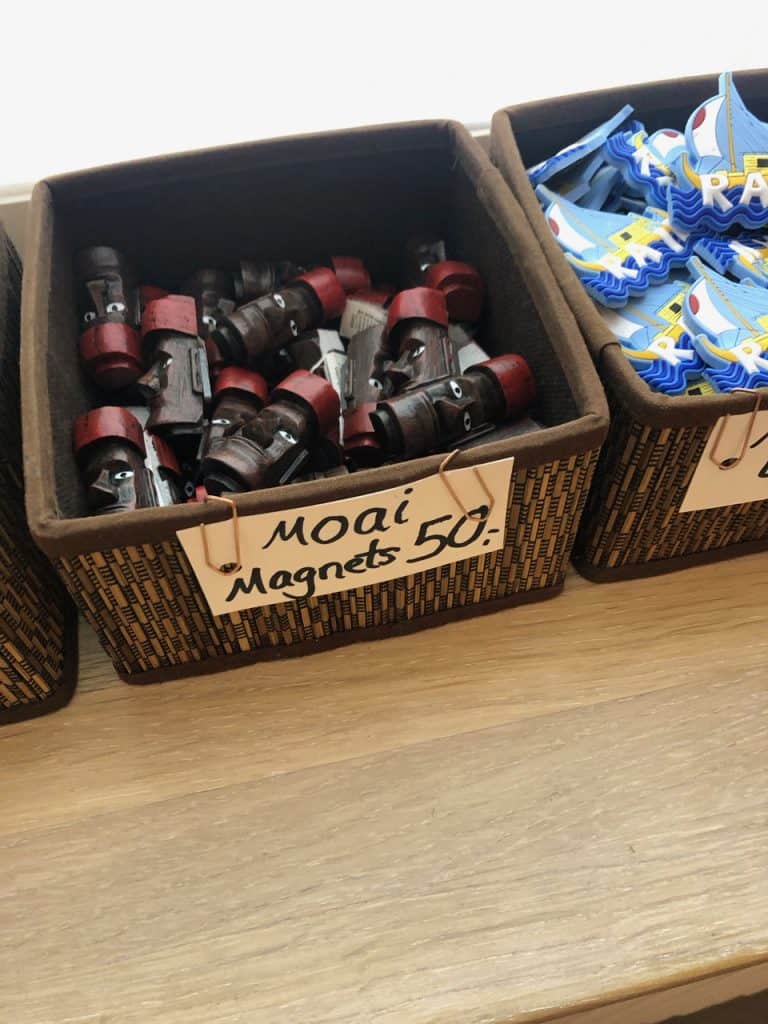
With proceeds from those going towards the museum’s work, I had absolutely no problem spending a bit of extra cash there.
Museum no. 2 – The Viking Ship Museum
After a great experience in the Kon-Tiki Museum, I was feeling all fired up for my next two experiences.
Despite the rain continuing to fall, rather than getting a bus (which in typical fashion I’d just watched pull away from the stop), I decided to walk to the next museum – which would take about fifteen minutes. There wasn’t that much to see en route – just plenty of big houses (I think Bygdøy must be a pretty pricey place to live)…
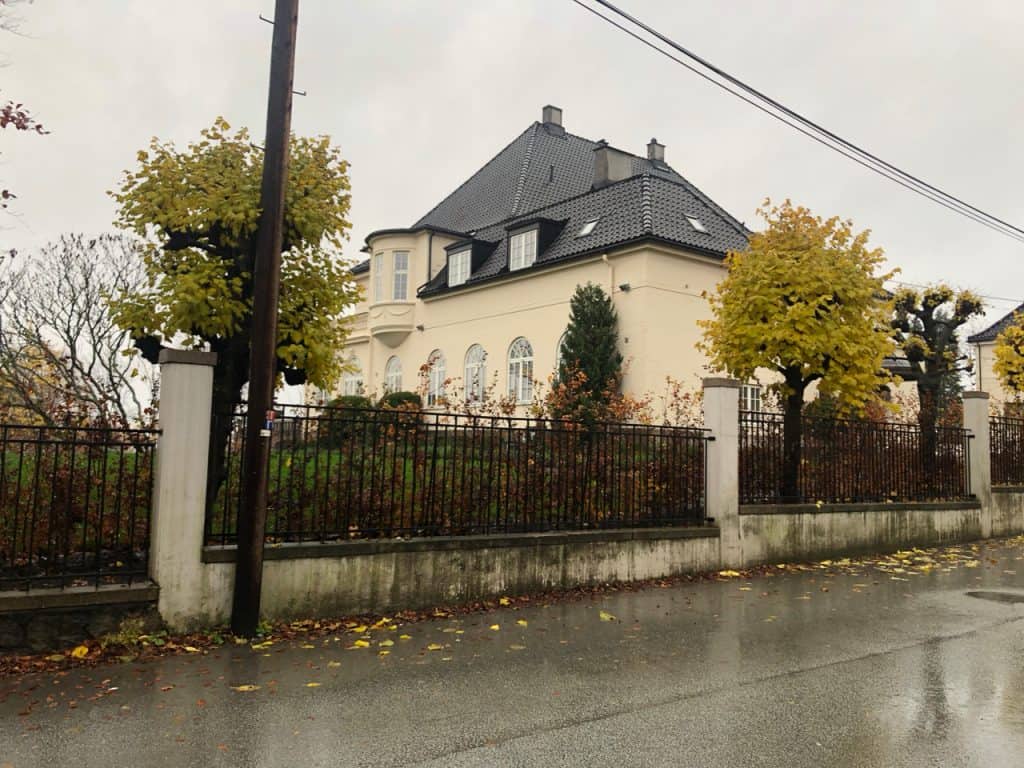
and construction work….

Eventually I arrived at Vikingskipshuset – or the Viking Ship Museum. Adjacent to the main building there was a hut containing free lockers for your bag.
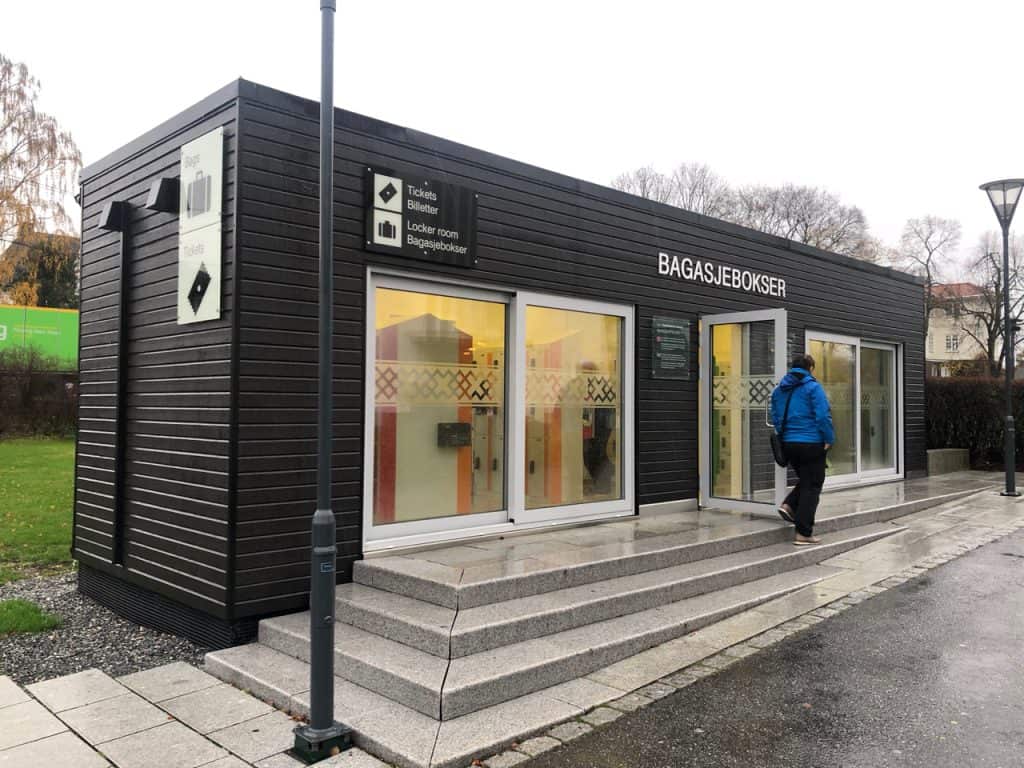
As I was putting mine in there, I heard an older couple talking about just getting the bus back to the centre of town. I couldn’t help myself – and asked if they’d been to the Kon-Tiki Museum. The lady said her husband had mentioned it as they’d spent an hour and three quarters in the Viking Ship Museum and he’d found it a bit painful. I explained how much I’d loved the museum, and the man said he thought it sounded brilliant. So off they went – sorry lady!
Next, I headed inside the main Viking Ship Museum building.
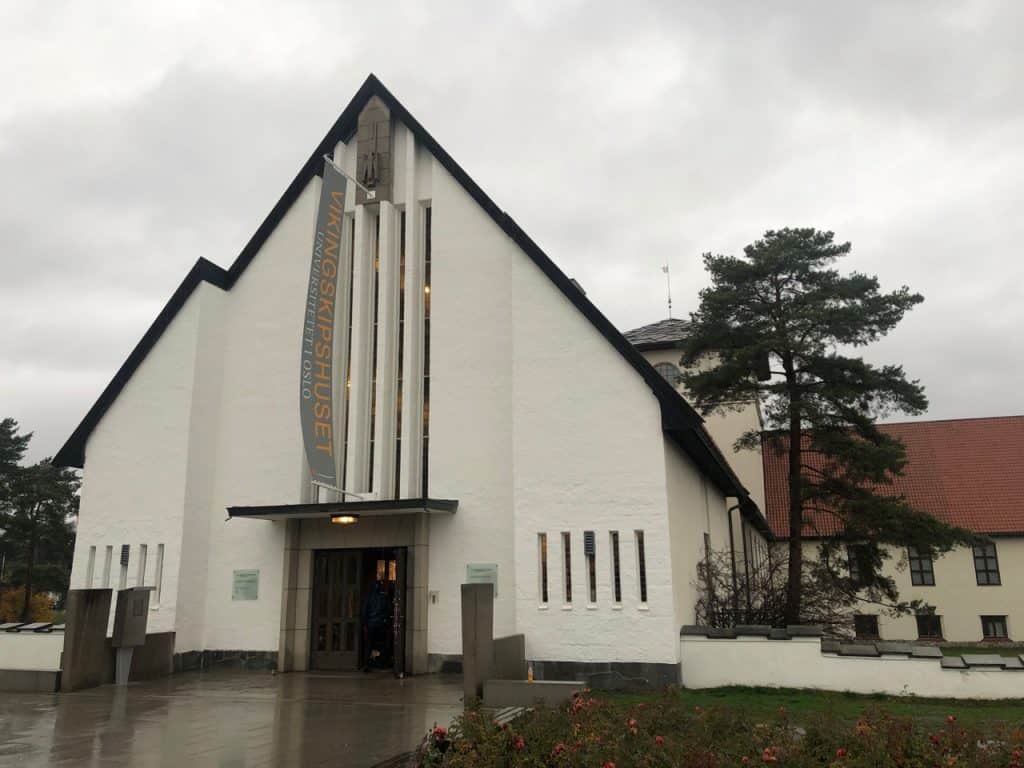
The small entranceway was filled full of peoples’ umbrellas.
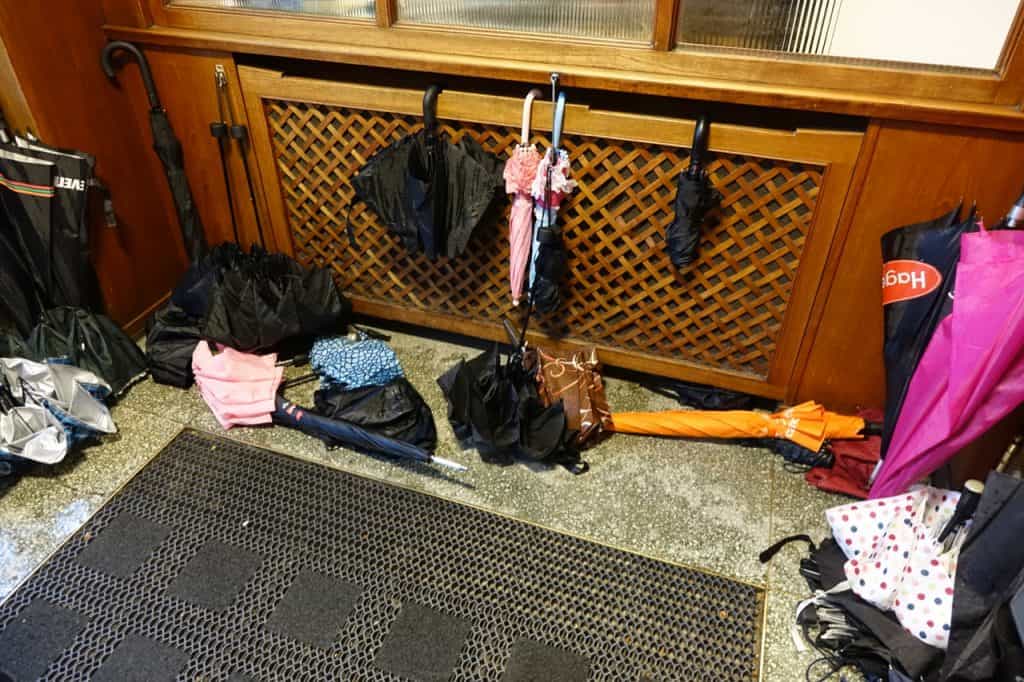
Now if that was at home, I don’t think anyone would leave their umbrella there in case it got stolen. I think it shows how trusting people are in Norway (and other Scandinavian countries) are – and deservedly so. I felt a twitch of panic/reluctance as I dropped my umbrella there – but decided what the hell. Yolo!
There was a small queue at the ticket window, and after waiting for a while I paid my 100 Krone entrance fee (about £9.20 at the time) and walked in.
The building was laid out in a cross shape, with one long hall intersecting with a shorter one. In the space are three Viking ships – all of which were sea-faring vessels before they were hauled onto land to be used in burial rituals. One of them dates from around 910AD.
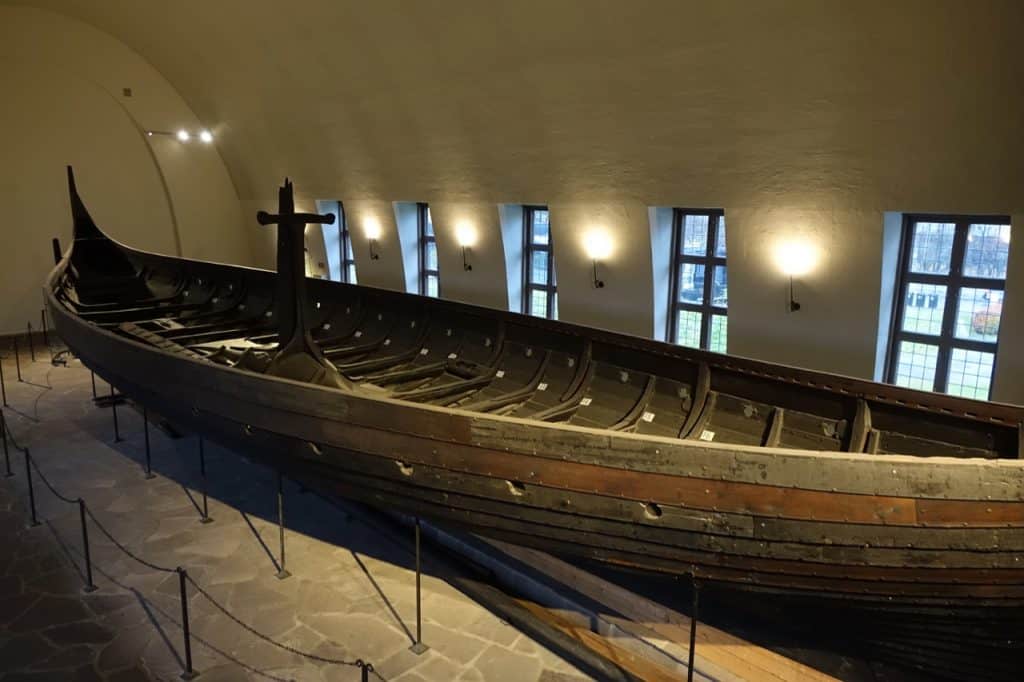
I wandered around looking at the ships. There were little staircases leading up to viewing platforms so you could see down into them as well.
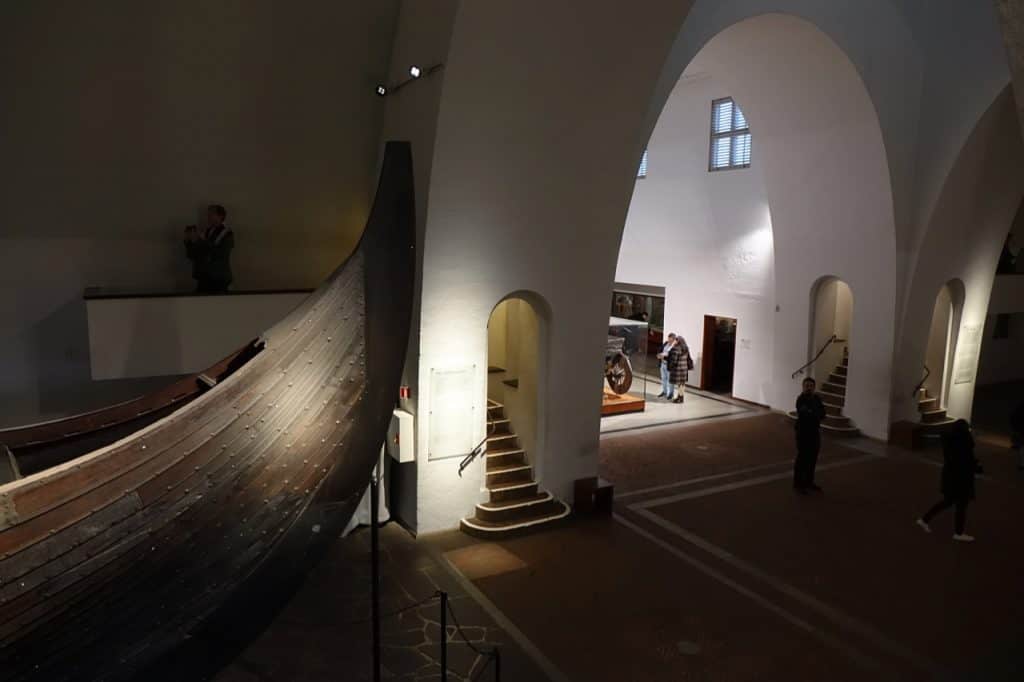
They were in amazing condition. Cabinets held displays of Viking implements and utensils – it surprised me how much they looked like what we’d use today for cooking and so on. There were also some very ornate sledges.

Every twenty minutes or so a film plays on one of the hallway’s ceilings. I was expecting a bit of an explanation about who the Vikings were and what they did, but it was basically just an animation of Viking ships at sea set to music.
After the immersive experience of the Kon-Tiki museum, I felt the Viking Ship Museum was a bit of a letdown
After seeing everything there was to see in around forty minutes, I collected my umbrella (still there!) and left to make my way to the third museum of the day.
Again, I decided to walk – again in the rain – enjoying the bright yellow displays of leaves as I went.
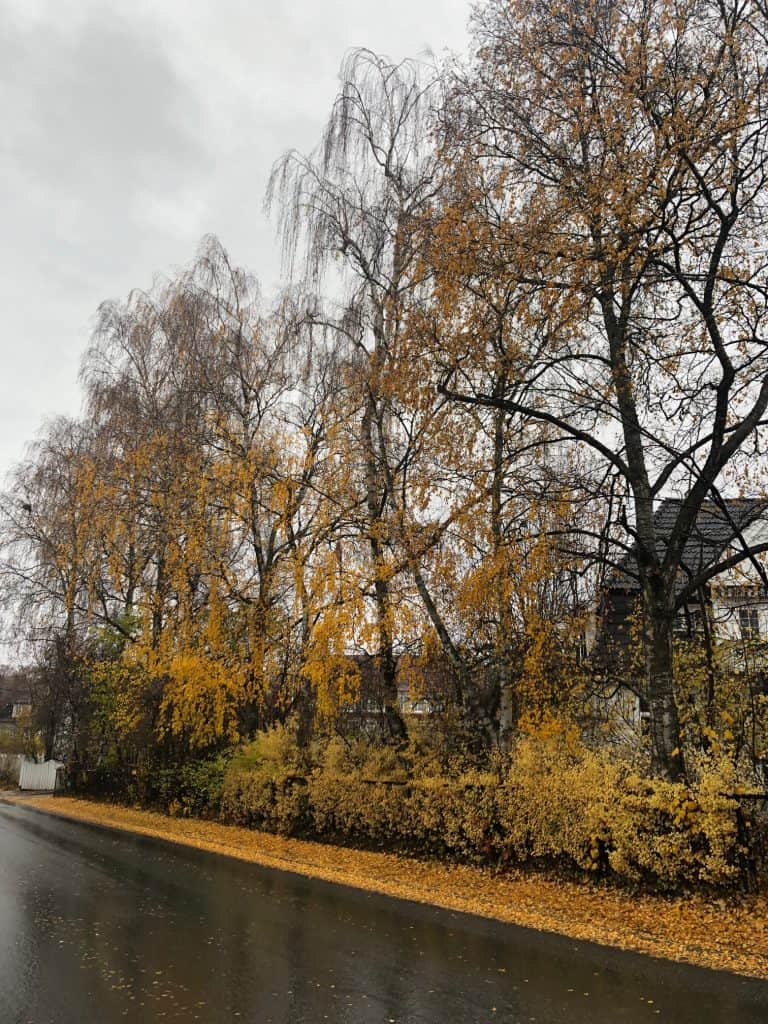
A quick spot of lunch
As far as I could see from my walk, lunch options were fairly limited on Bygdøy. So I decided to have my lunch at Kafé Arcadia – the café adjoining the last museum I was going to visit.
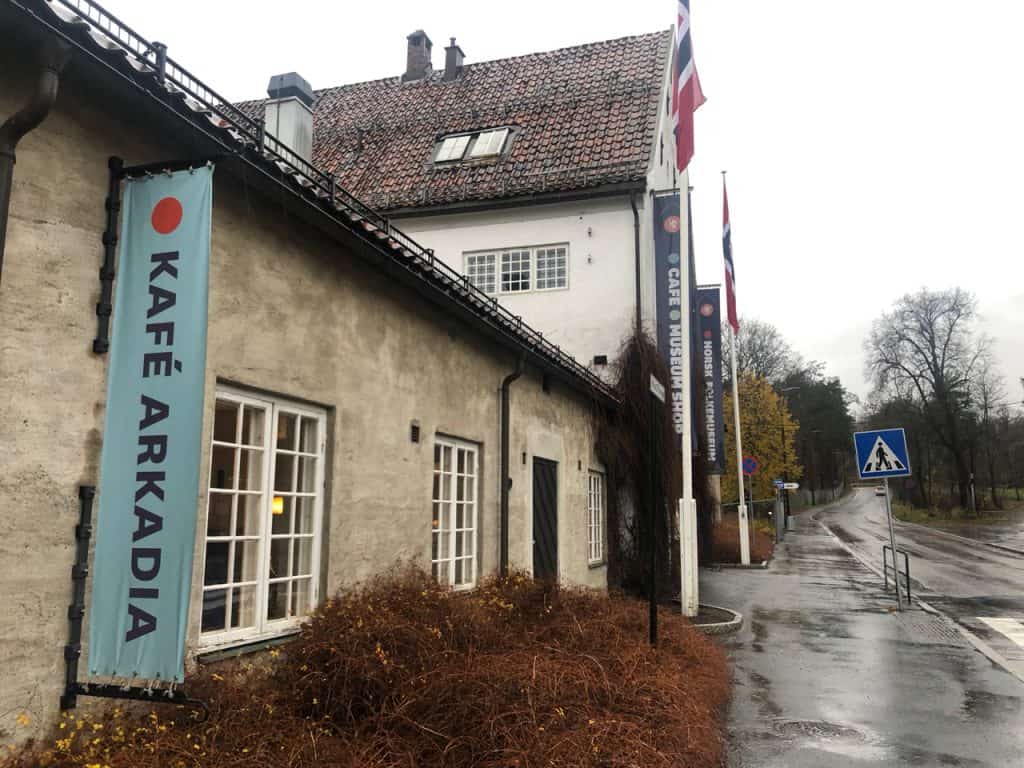
The café was the perfect place to escape from the grey, wet day outside. It was warm and decorated in typically Scandinavian fashion – all pale wood and white walls.
I selected my meal from the counter – an
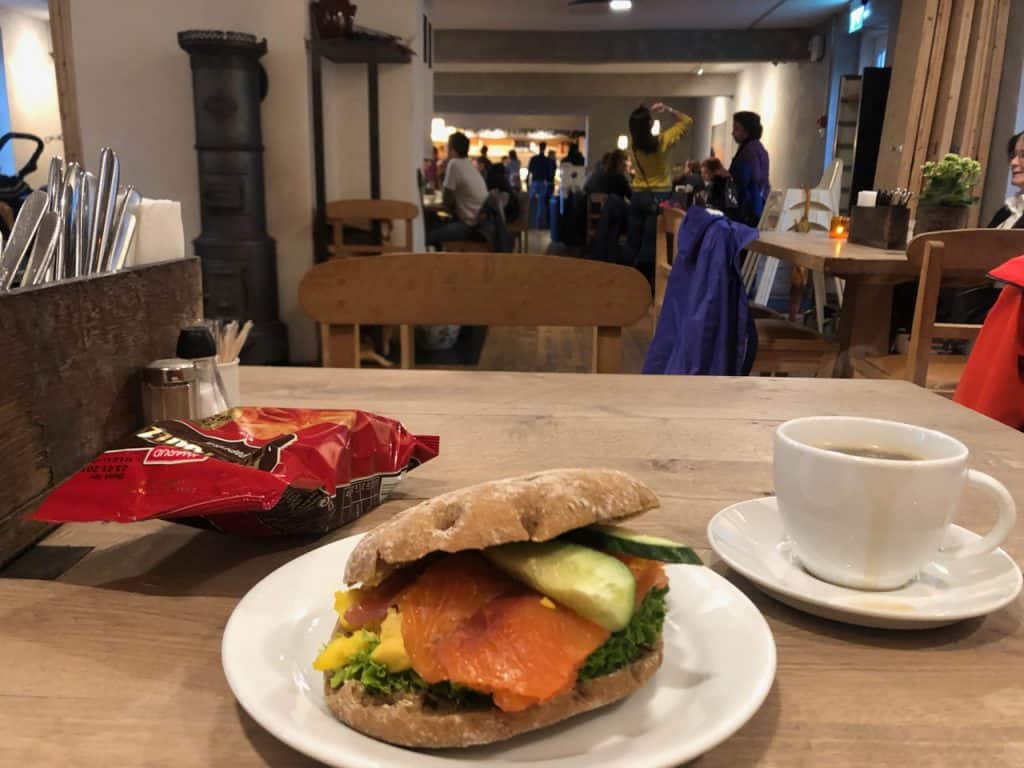
That little lunch cost 163 Krone – about £14.90 – so like everything else it wasn’t cheap!
Museum no. 3 – the Norwegian Museum of Cultural History
After polishing off lunch, I made my way under an archway and into the building adjoining the cafe to buy a ticket for my last museum of the day.
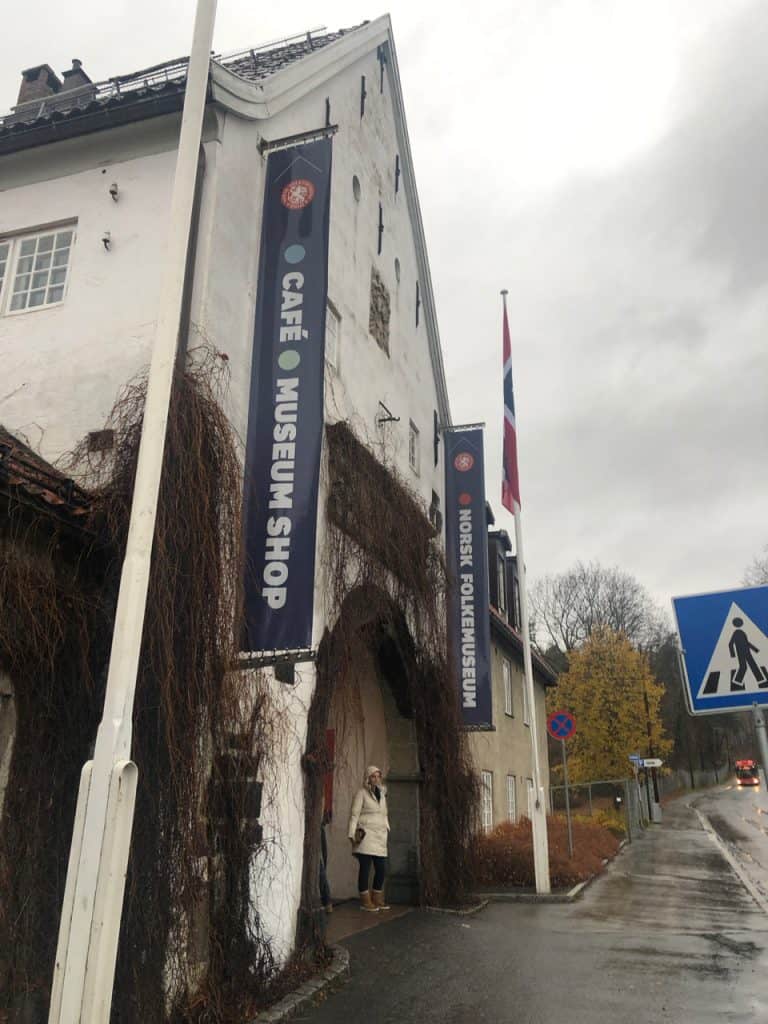
I’d arrived at the Norse Folkemuseum – or the Norwegian Museum of Cultural History. Entrance was 130 Krone – about £11.90, and the man behind the counter also lent me a 10 Krone piece so I could dump my bag in a locker.
Once I’d got my self all sorted, I grabbed a map and walked outside to enter the museum through a turnstile. It didn’t look too enticing 😩….
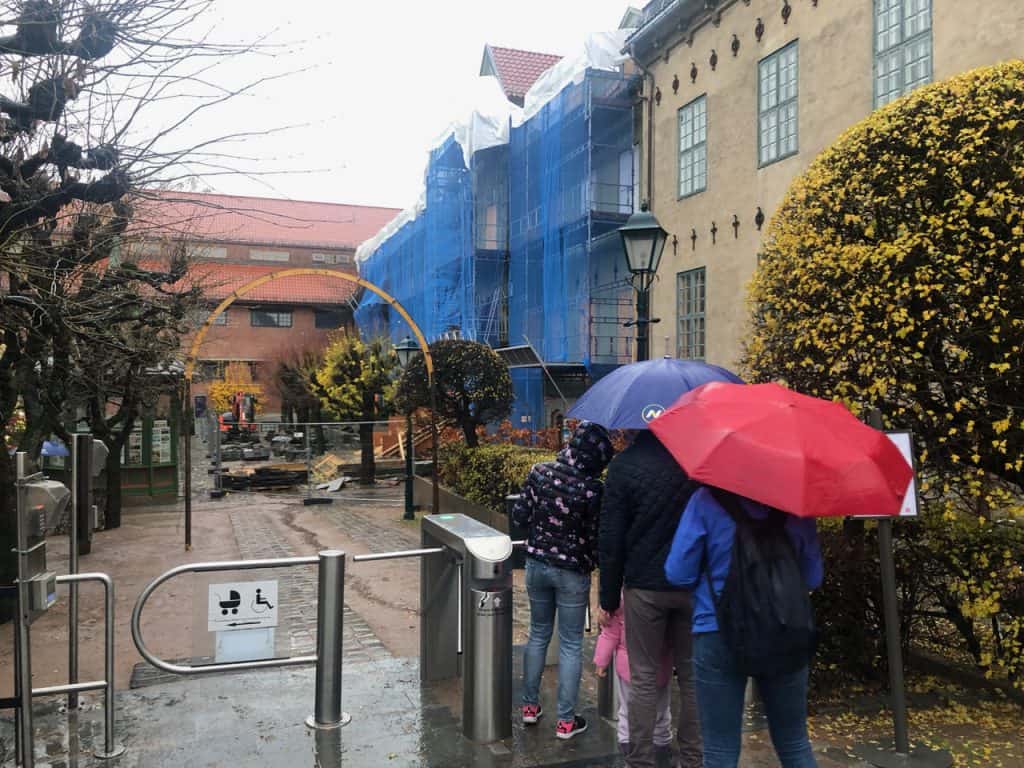
Just around the corner from the turnstiles was a square surrounded on three sides by buildings. The map told me they contained various exhibits, so I headed towards the white one in the picture below and stepped inside.
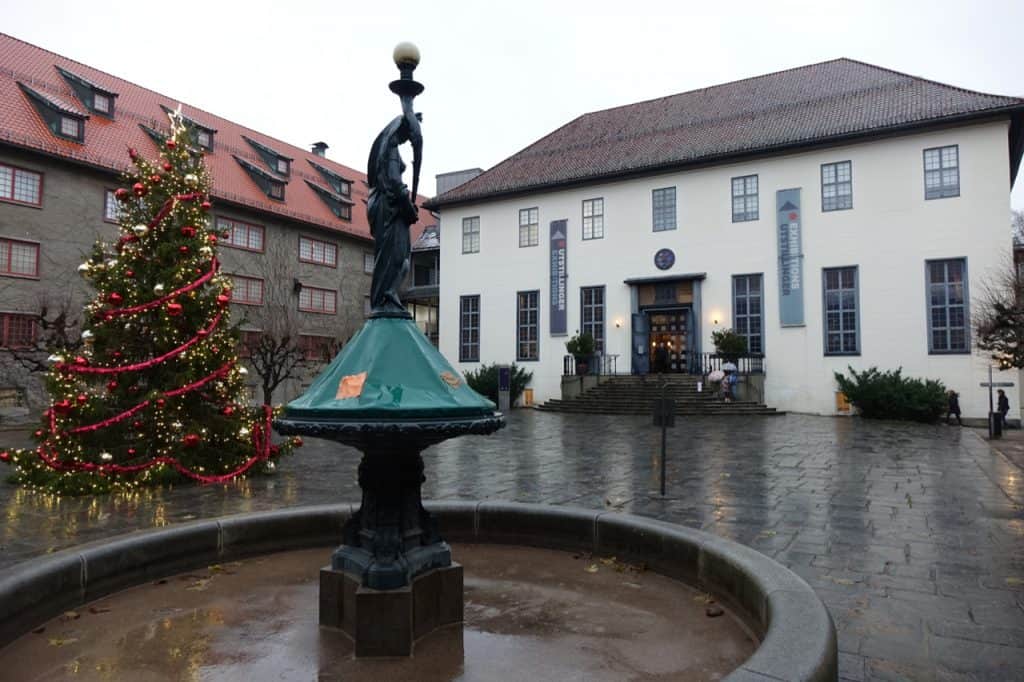
It wasn’t immediately clear which way to go, so I walked through one doorway and entered an exhibition about Norwegian Folk Art, covering the subject from the Middle Ages to the 1900s. There were loads of items and bits and bobs in cabinets, so I wandered along, having a look at them and reading the occasional bit of accompanying text.
There was also an exhibition covering knitting which was a bit random. Some of the knitting needles were massive!

I walked around that quite quickly, then took the stairs up to the first floor. There was plenty of noise coming from there – which I discovered was down to loads of excited kids being shown how to make Christmas decorations and decorate Christmas biscuits.
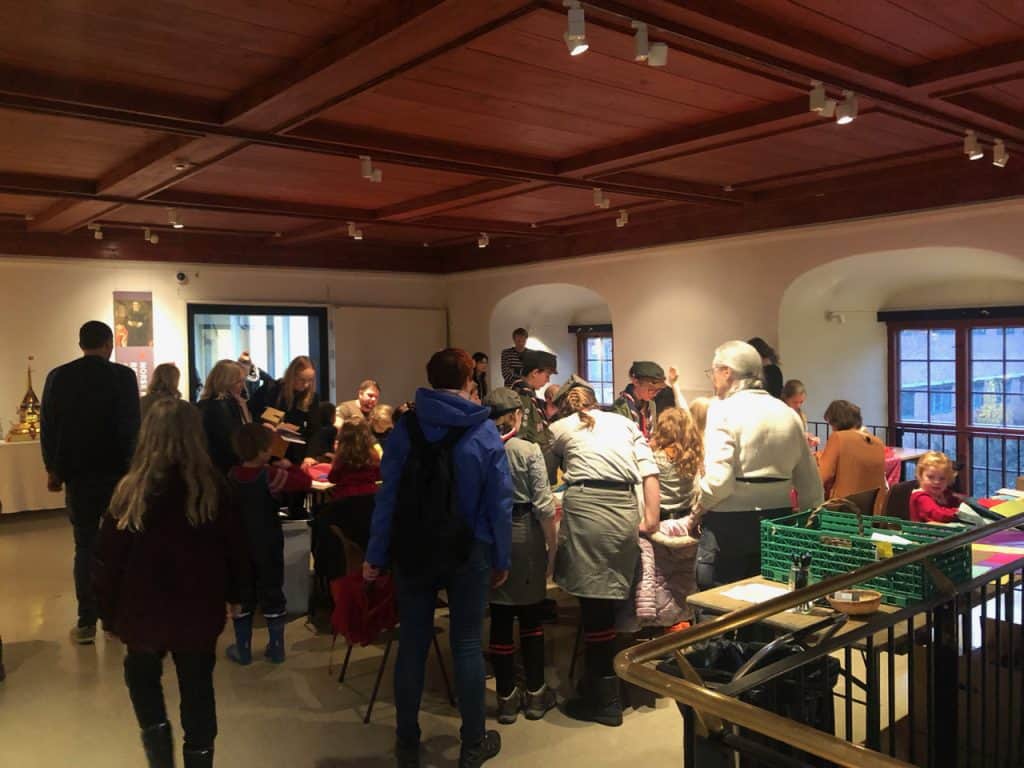
Near where that was taking place was another exhibit on Norwegian folk d
Stepping outside, I heard a singing coming from another building so followed the sound of music through a doorway then upstairs until I got to a room with a balcony. Below, a seated audience was watching a man sing accompanied by a piano.

I descended the stairs to the basement and stuck my head in the hall where the music was coming from. By now the man had been replaced by a lady – you can see what she sounded like below.
It didn’t look like there were any more particularly interesting exhibits down there, so I headed back outside.
So far I’d felt the museum was a bit like the Viking Ship one – a bit dry. But at least there were loads of activities on for kids – some of which I wouldn’t have minded joining in on!
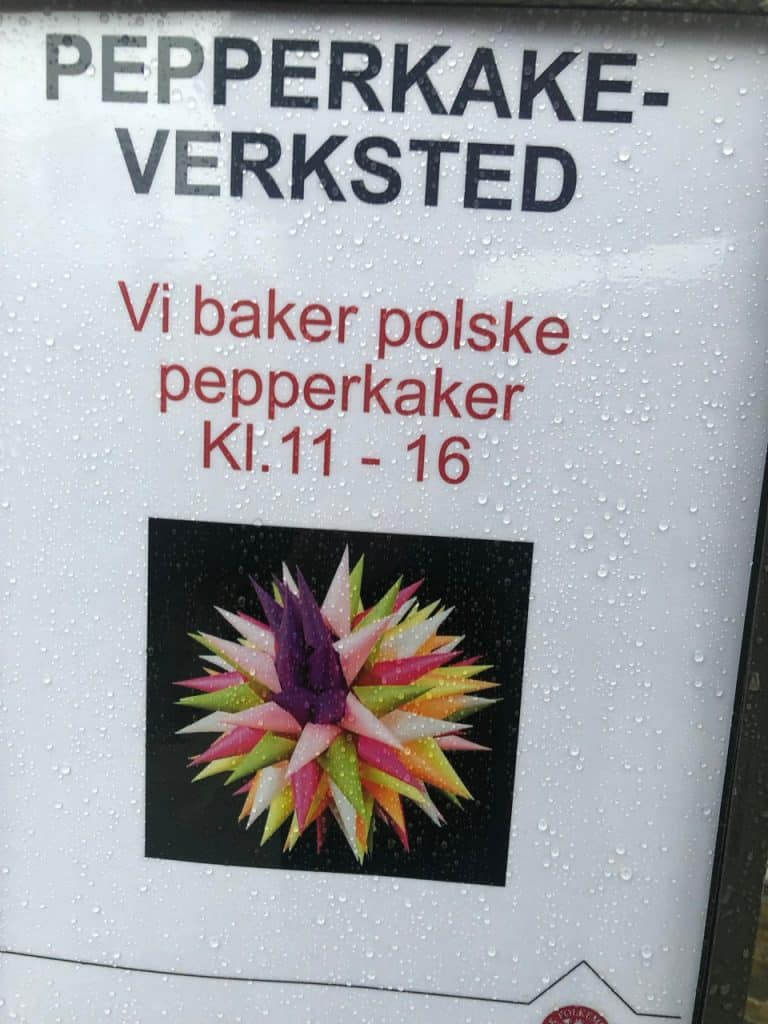
Things changed though when I walked around the corner from the square and its three buildings. I’d arrived at the start of the museum’s open-air area, which looked a bit more promising!
It’s split into different sections, and shows how Norwegians lived in different areas and times. The first section I’d stumbled upon was “The Old Town” which contained buildings from the town of Christiana and its suburbs. Christiana was built on the foundations of the current Oslo after the existing town was destroyed by fire in 1624.
This was a bit more like it to be honest! There were original buildings which you could step inside to see how people had lived at a particular time in the past.
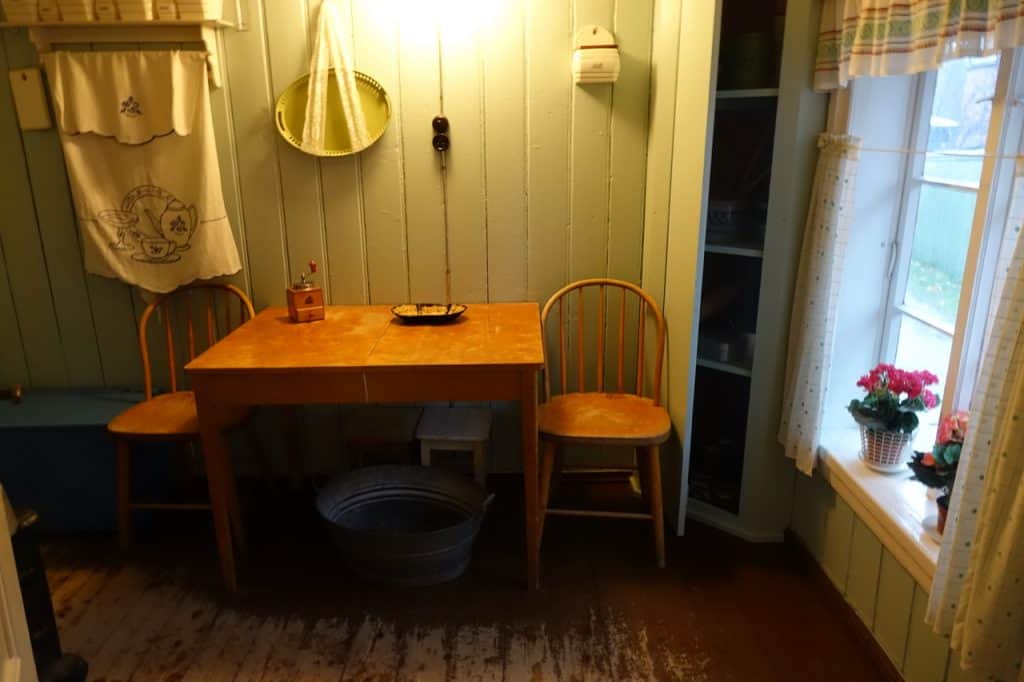
What I liked though was that outside most buildings were pictures and a bit of text about the actual people that had lived there. That made it more interesting for me – being able to imagine them actually living there as you stepped around a room.
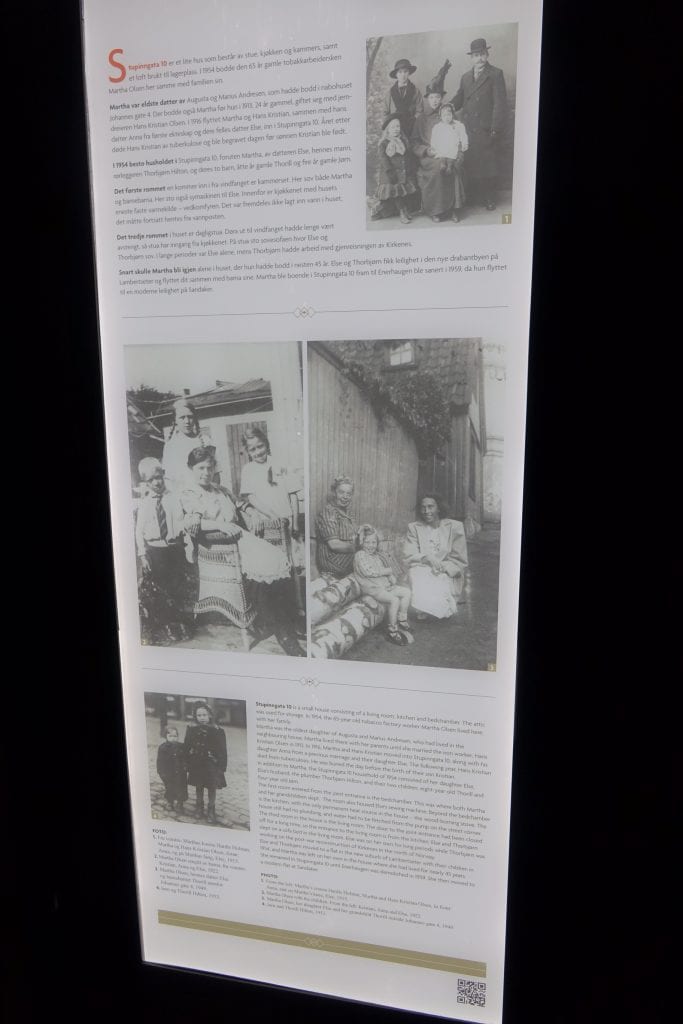
There was an old tobacco and grocery shop you could have a nosey around in…

…which was well stocked with goods…
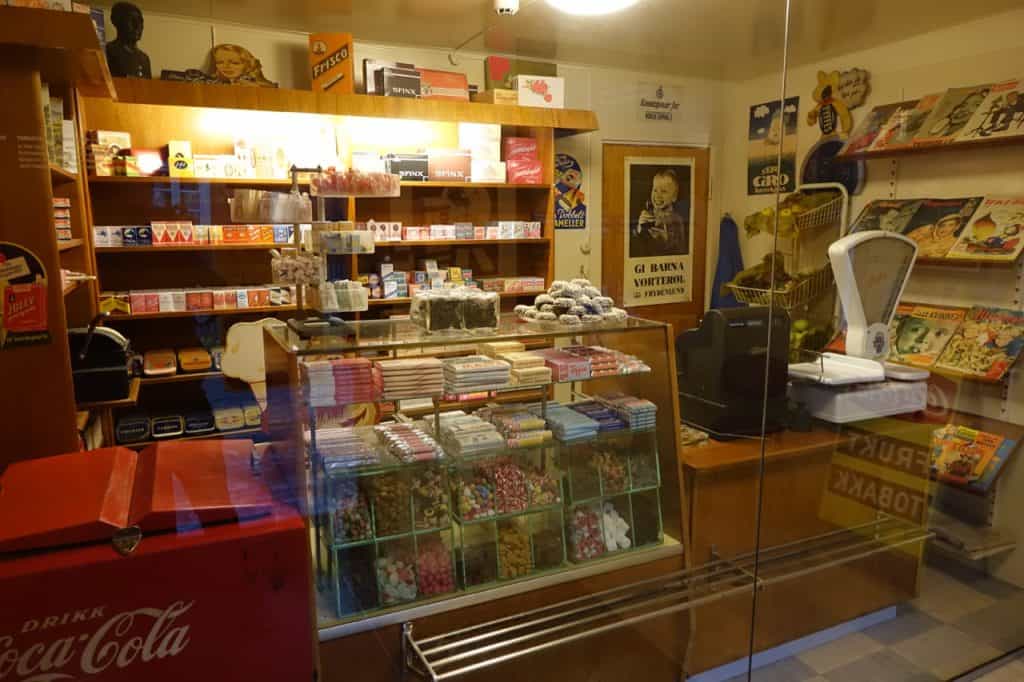
…and also home to a small exhibit about tobacco – which included this great picture of Oslo paperboys enjoying a fag back in 1905. Check it out – one of them has a pipe!
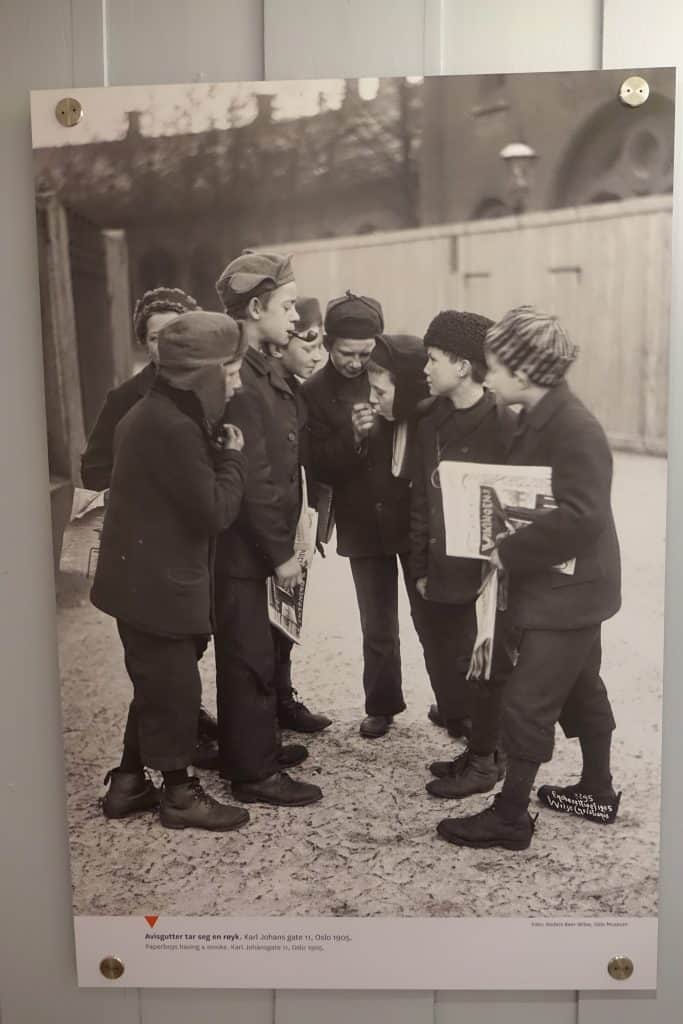
If the weather hadn’t been so wet and miserable, it would have been really pleasant strolling around the place. Having to constantly raise and lower your umbrella and look out for massive puddles as you went from one building to another was a pain though.
I had a look inside an old bank, and recognised a bankie I definitely had as a kid (mine was branded TSB, not DnC)
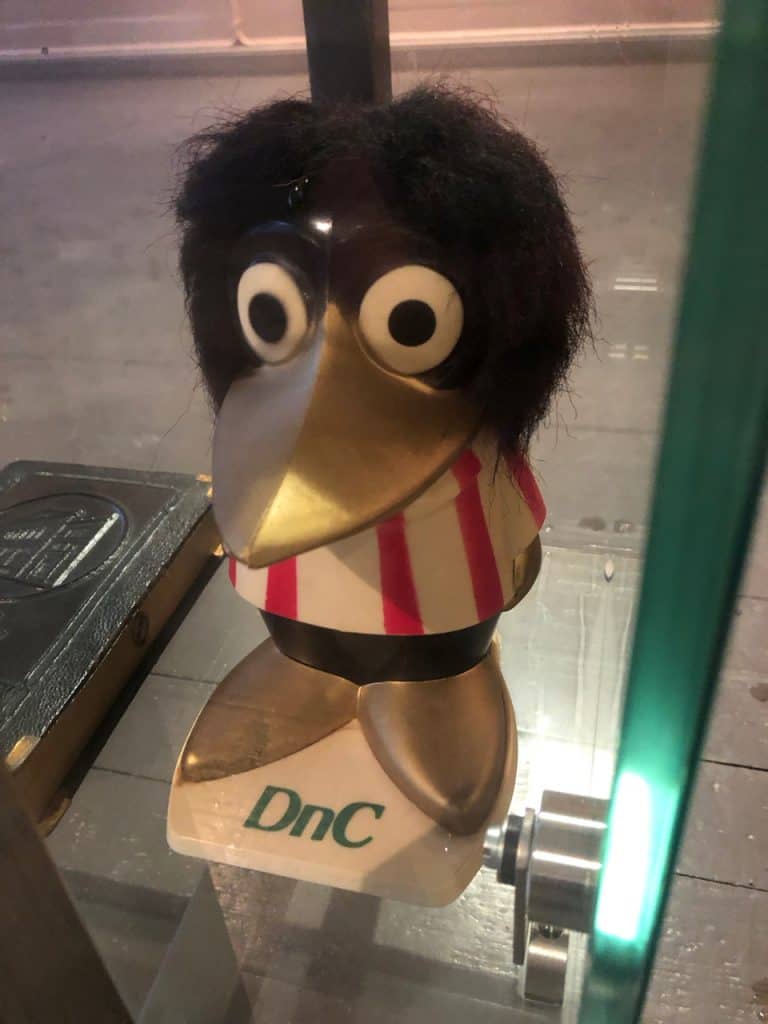
Leaving the old town behind I passed a building which had a modern sign outside saying “Potter, Silversmith and Weaver’s Shop”. Presumably there normally would have been displays and activities running there, but today the building was shut.
Next I came across an apartment block. The way all the random buildings and streets were laid out reminded me of a TV drama or film set.
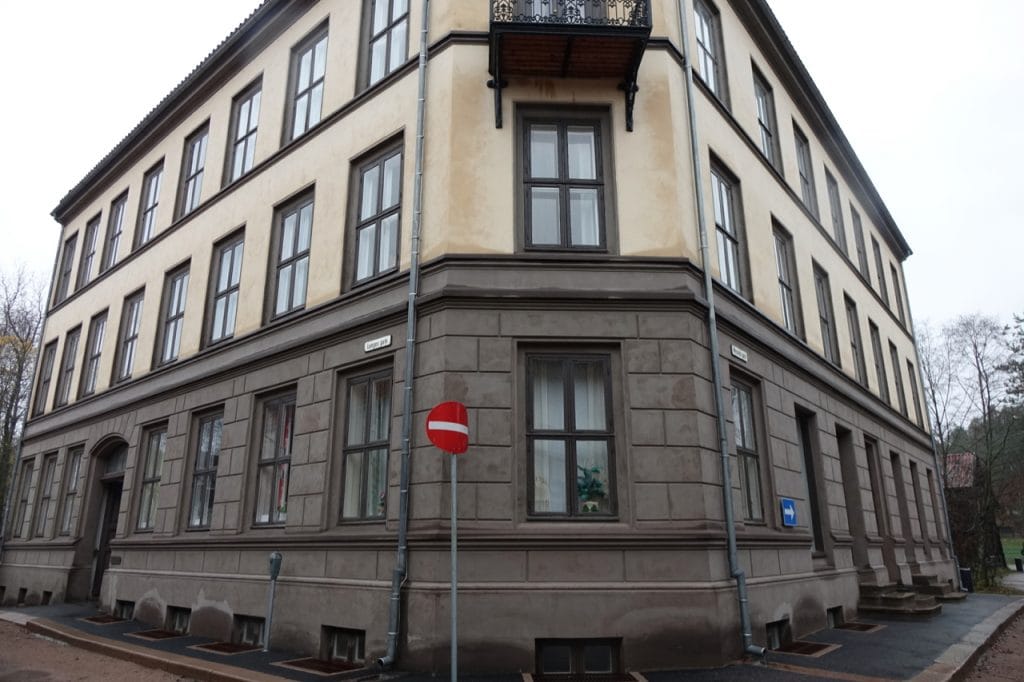
Inside there, again you could see pictures of who had occupied each apartment, and in this instance – how little room a female art student had to live in. Her bunk bed was just to the right in this picture – you can see the ladder leading up to it.

Some of the rooms had really cool sixties and seventies style decor that I’d be completely happy with at home today.
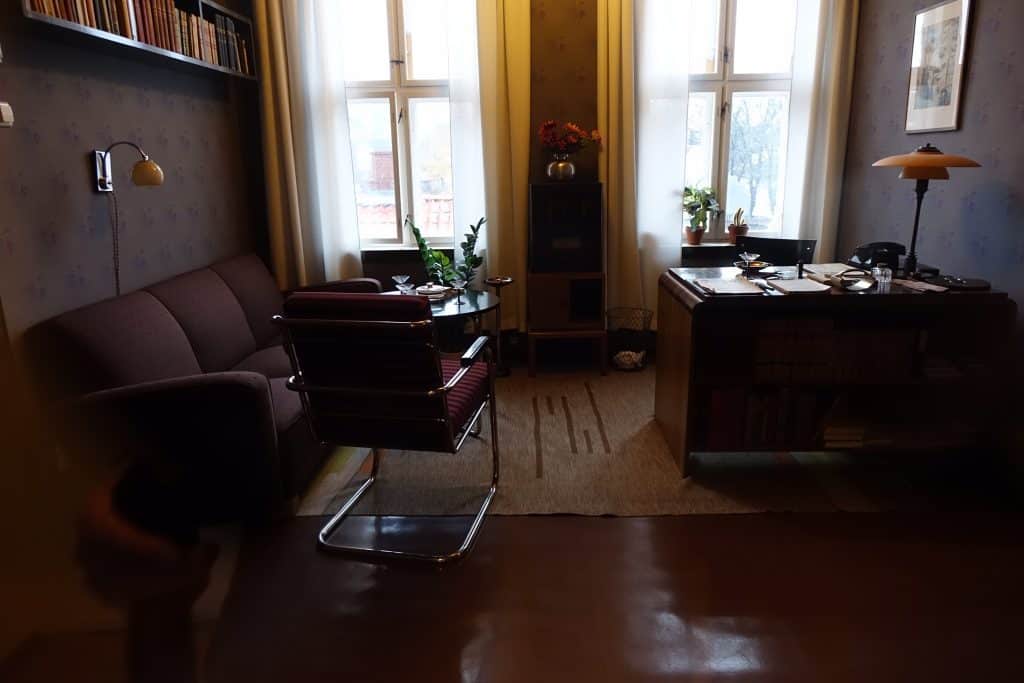
One end of the apartment block held an old style Vinmonopolets and an exhibit on how Norway’s state run alcohol shops came about.
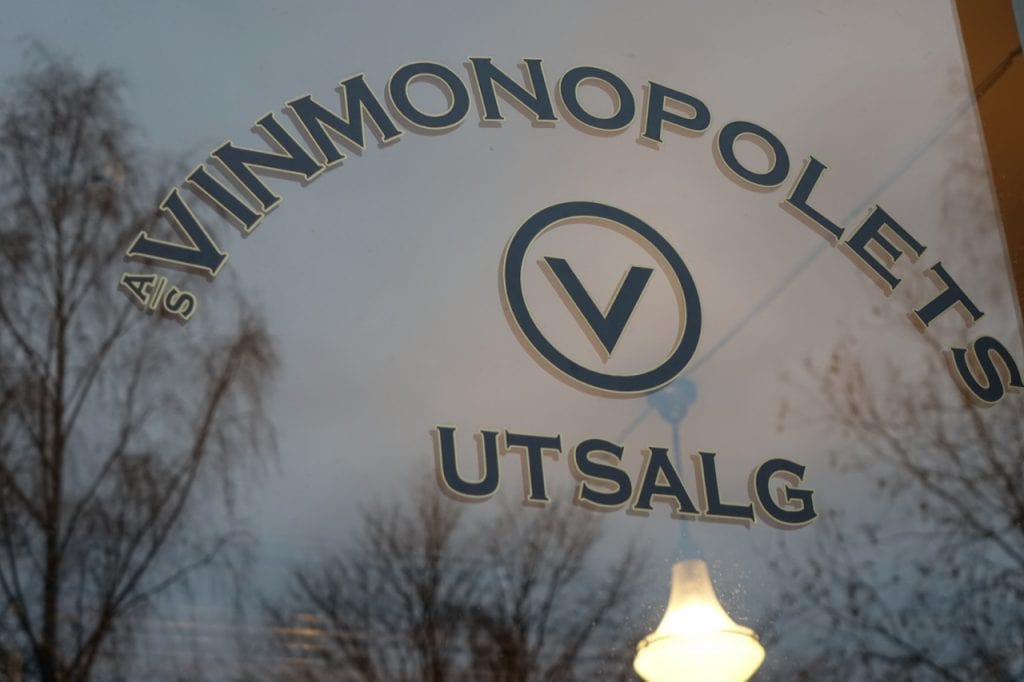
And across from that was an old petrol station which looked pretty cool.
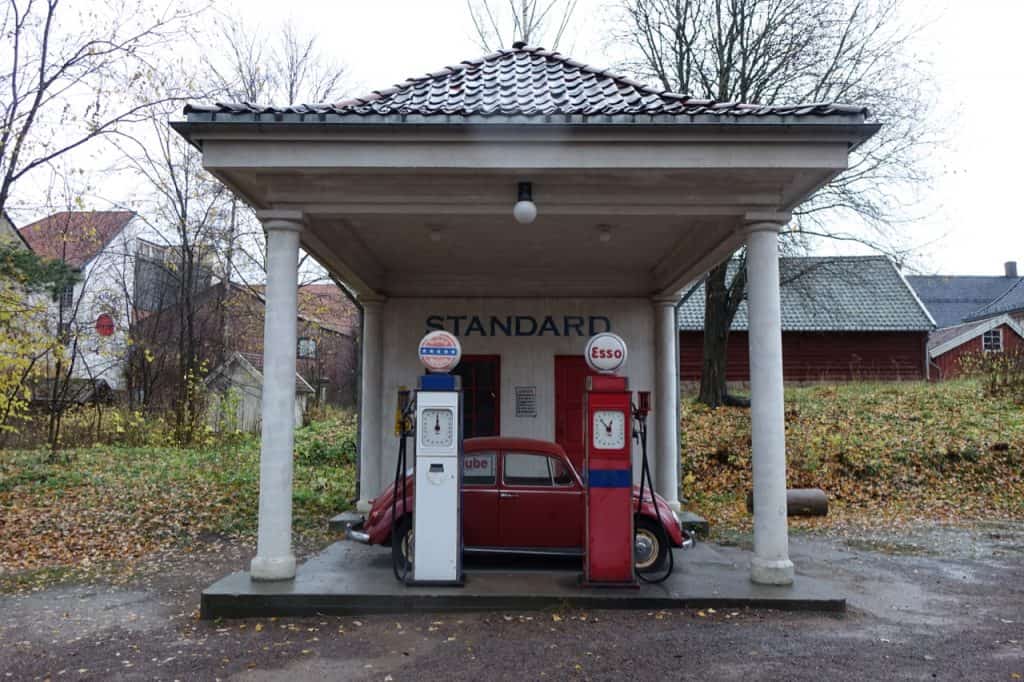
The rest of the open air section of the museum was dedicated to the countryside, and consisted of old farm buildings or country dwellings from various periods.
I couldn’t really be bothered with this bit, but walked around it anyway, just in case I missed out on anything spectacular. There were clusters of really old looking buildings, some of which would contain a fireplace or a real-life lady dressed in period costume, but most of them appeared to be empty.
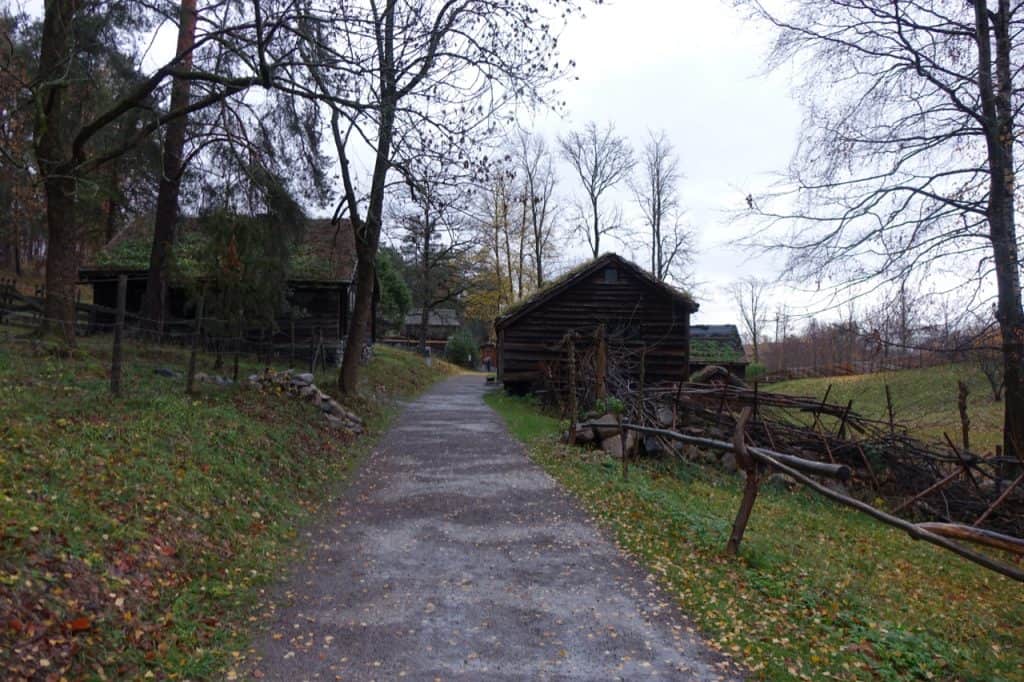
Again, it would probably be great in the right weather, but it was a bit miserable in the rain. The most exciting thing I got to see in the countryside section was two pigs….
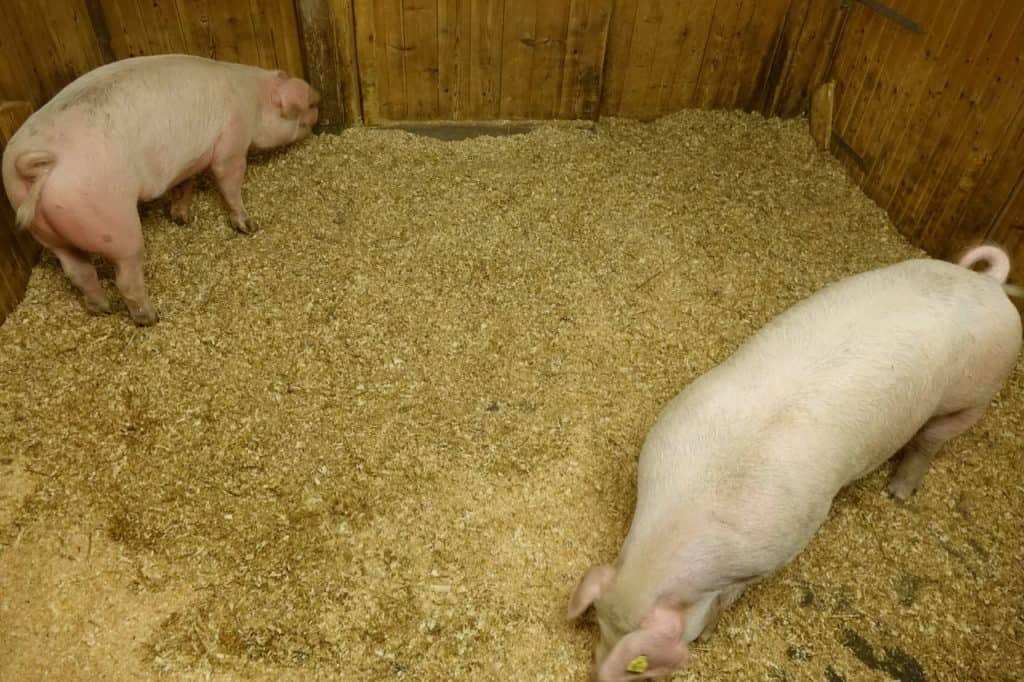
And a lady herding geese! Just managed to catch a picture of that…
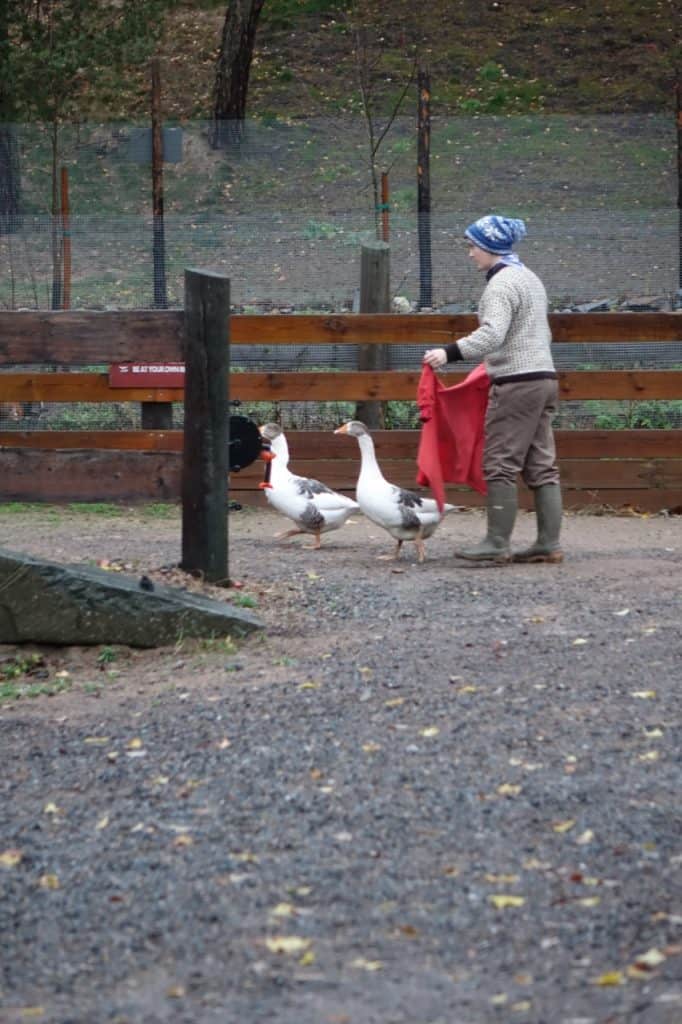
Eventually I arrived back at the square, and collected my bag, returning the 10 Krone piece I’d borrowed to the man behind the counter. I’d rank the Norwegian Museum of Cultural History probably second out of the museums I’d visited that day. But I think my experience of it really was tainted by the weather. If I’d have come in the summer, I think there probably would have been much more going on, and it would have been more fun too.
A laundrette with a difference
Thankfully I didn’t have too long to wait outside the museum before the number 30 bus came to take me back into town. This time I opted to buy a 24-hour ticket in the app. I had a couple of journeys coming up as I had a little errand I needed to take care of!
I’d miscalculated how many day’s clean clothes I would need for the trip, so needed to do some laundry. I’d checked at the hotel – but with their prices running at £17 per t-shirt (plus a ‘call for weekend charges’ notice) – I decided not to bother and to go somewhere else. And it was there I was headed now.
After changing buses at the Solli stop, after a total of about half an hour, I arrived in the Bislett area of Oslo. I disembarked just beside Bislett Stadium – one of Norway’s best-known sports stadiums.
Across the road from that was Cafe Laundromat, a – you guessed it – laundromat with a cafe. Or a cafe with a laundromat.

I stepped inside and followed the wooden sign pointing towards the laundry, only to be greeted with a row of washing machines. Behind me was a row of what I suspected to be tumble driers.
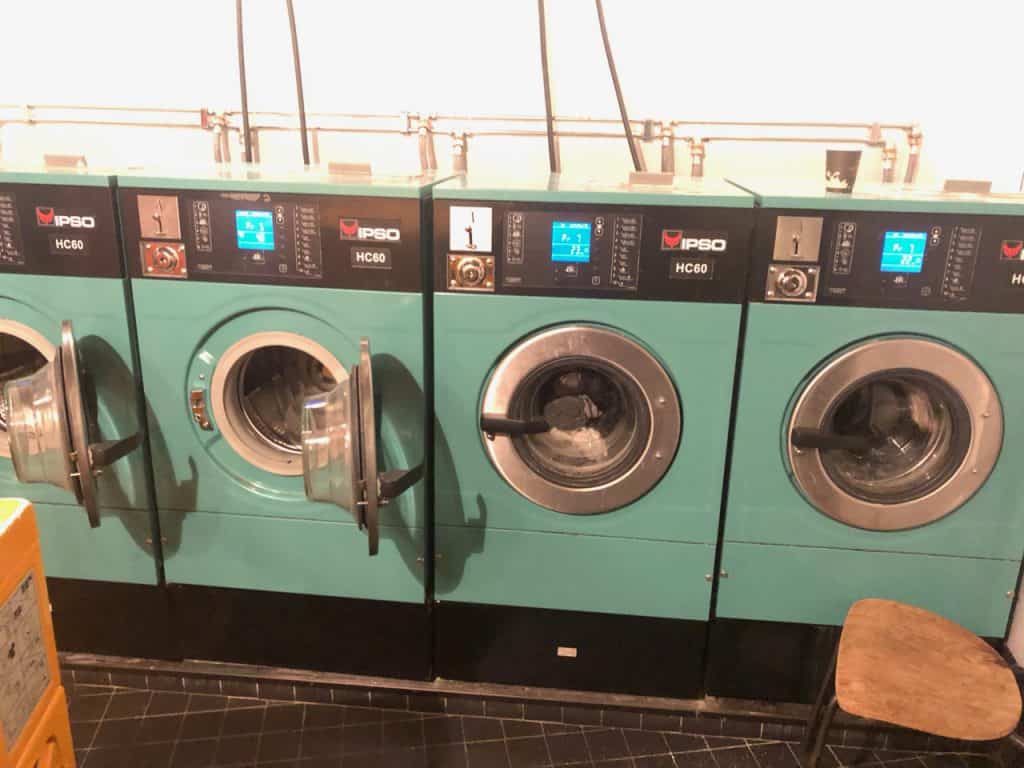
I had no idea what was going on!
There were coin slots, but no laundry powder in sight. I’m not the best to be honest at working out unfamiliar washing machines. I could tell this would have me stumped without some help. I didn’t have any cash on me either, given that I’d been relying on card payments everywhere.
I walked up to the cafe’s bar, where I managed to get steadfastly ignored by every member of staff for about ten minutes. So eventually I just asked a passing waiter about the laundry. He told me that they’d just noticed the information sign there normally was missing, and to ask at the bar.
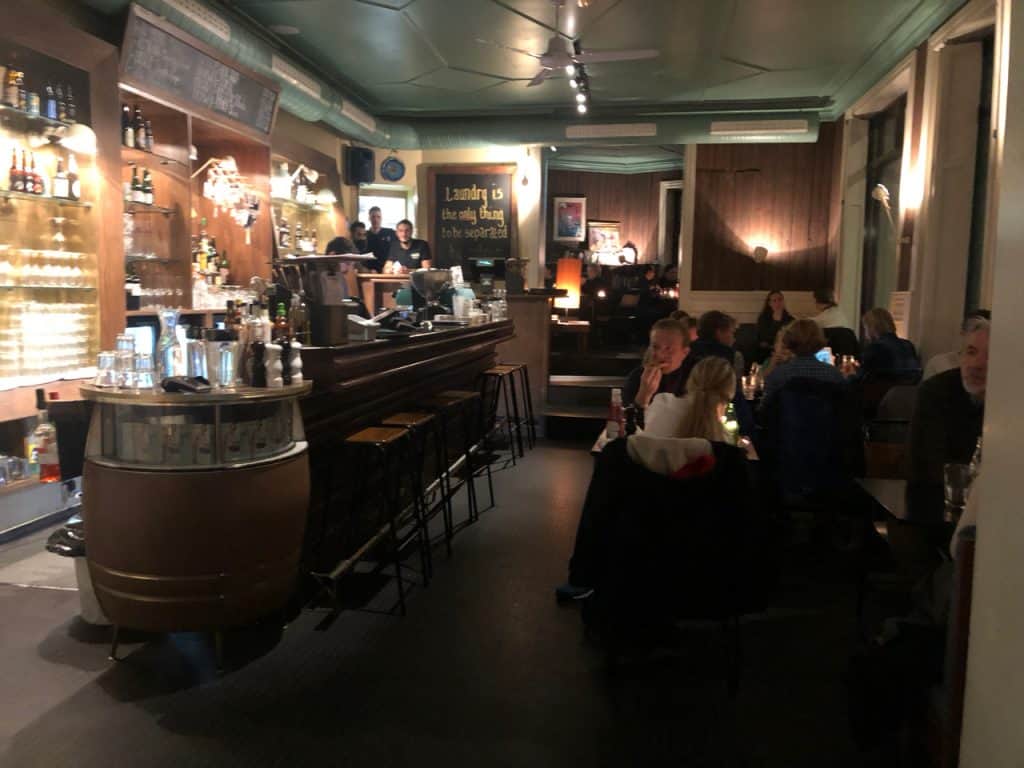
So, eventually I got the lowdown from a slightly harassed yet still kind of friendly barman. He explained he could give me coins for the washing machine and tumble driers, and that they’d probably take half an hour to an hour each depending on how much I had to wash.
I asked if he could come around and show me how to use them but he pointed out the machines had instructions on them 😩. So I paid up, ordered a mocha as well to sip on while my clothes spun, and headed back to the machines.
Thankfully, standing right there unloading a washing machine was a good samaritan. And he spoke perfect English, explaining his Mum was from Telford, but his Dad was Norwegian, and it was the latter country he called home now. (Also that his washing machine was currently broken). He explained how to operate the machines, and after we both hunted for powder, I headed back to the bar and bought a capsule of Ariel for the sum of £1.37.
After selecting a programme on the machine (I’m sure you’re enjoying this blow by blow account) I put some money in, and nothing…. The display changed from a ‘5’ to a ‘4’. Putting another coin in took that to a ‘3’, so I eventually plugged more Krone in until lo and behold – the display reached zero and the machine started.
I set a timer on my phone for 30 minutes and went and took a seat to enjoy my coffee and write a bit more of my blog.
The cafe was really ‘homely’. It was filled with a crowd of all ages, who mostly seemed to be locals. There was a really nice atmosphere, and the music playing wasn’t bad either. Also the food (which I didn’t sample, still being full from lunch), didn’t look bad at all.
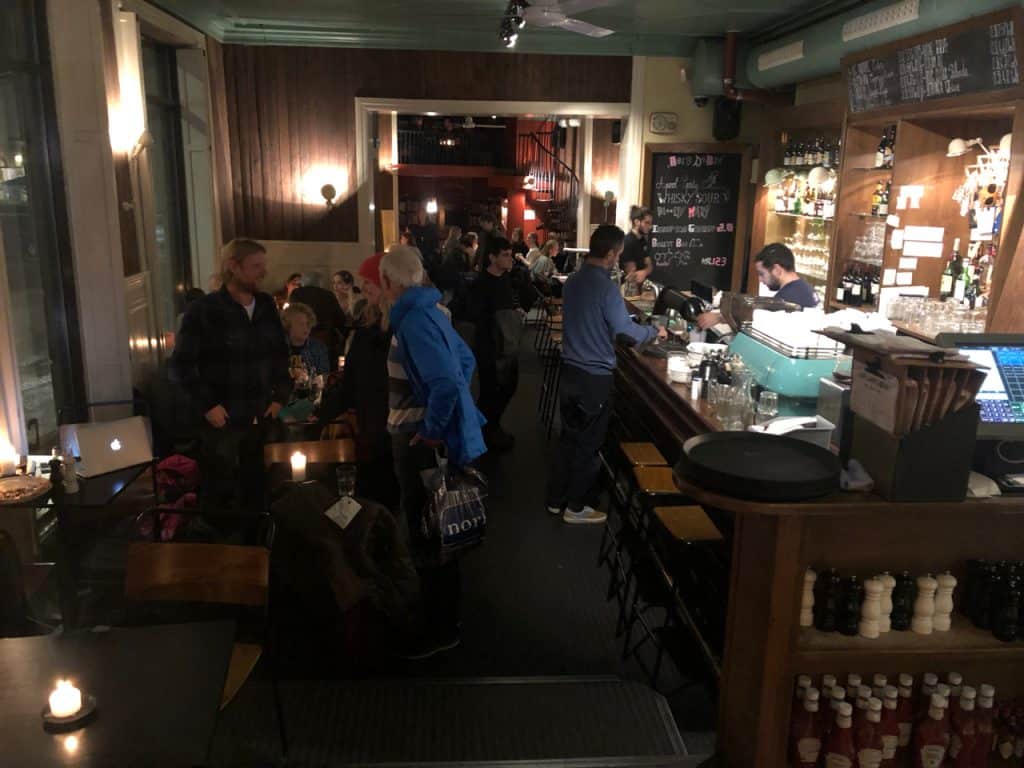
Eventually, my timer went off, and amazingly my washing was ready. I popped it in the tumble dryer while I continued with my coffee and blogging, and another half an hour later I was good to go.
My coffee, washing and drying had cost just under £13.50. Sure it wasn’t cheap, but it was a lot cheaper than using the laundry at the hotel.
Dinner and a cocktail with Bubbles
After getting the bus back to the harbour, the rain was still coming down as I walked back to the hotel. By now I was really looking forward to a sauna, steam bath and swim – so that’s exactly what I did, once more grateful that I wasn’t having to pay the spa entrance fee hotel residents are usually charged.
It was my last night staying in The Thief, and I knew I was going to miss it – my room was great, the bed was amaaaaaaazing, the breakfast was filling, and the spa very relaxing. I had paid more than I would usually have for my stay, but I was really glad I had.
With my last trip (for now anyway, I wouldn’t mind a return visit!) to the spa over, I headed out to stroll around the Aker Brygge area again to find someplace to eat. I had planned to dine at Mathallen, the food court I’d visited the other day, but annoyingly it turned out that it was only a bar there that was open late on a Sunday – the food places closed around 6 pm. And it was closed all day on Monday, so annoyingly I’d not get to sample the place’s wares on this trip at all. Should have checked that out beforehand I guess!
So Aker Brygge it was for dinner for the second night in a row. And this time I wasn’t looking to inflict as much damage on my wallet as I had the night before. In the end I settled on a branch of Olivia – a small Norwegian chain of Italian eateries.
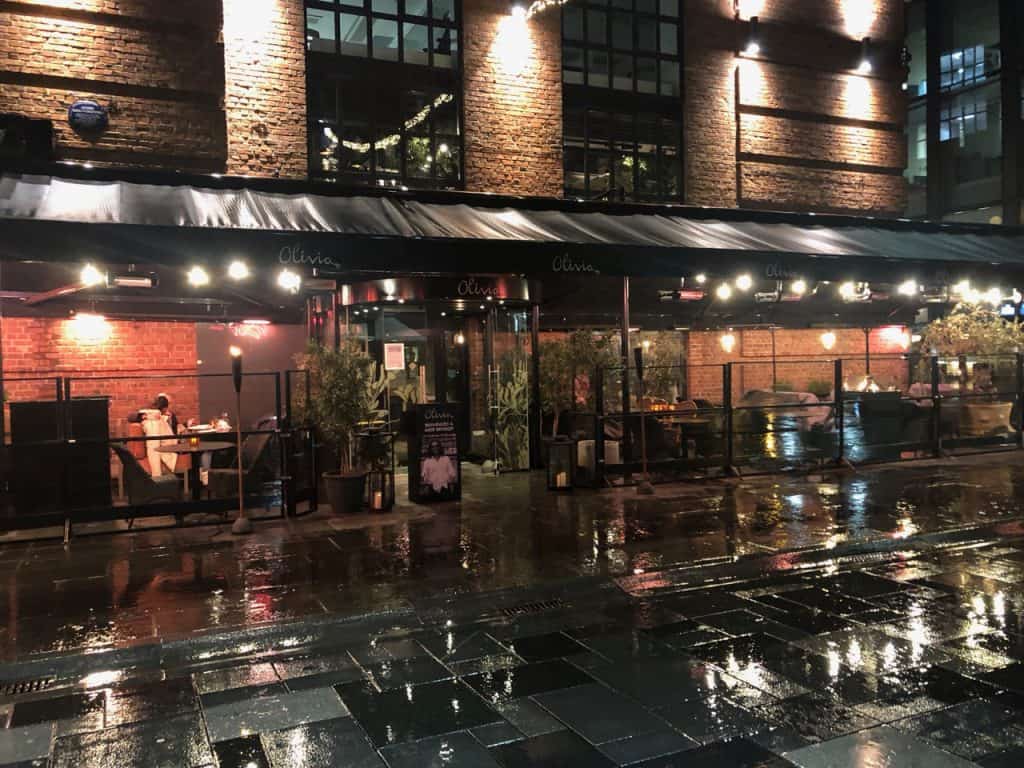
I ordered a glass of Chardonnay from a very attractive waitress, who over the course of the evening (and another glass of Chardonnay) I completely fell for. Anja if you’re reading this…!
I decided to go for a Capricciosa pizza from the menu’s extensive list – topped with tomato sauce, mozzarella, mushrooms, oregano, ham, artichoke, olives, and as an added extra, anchovies. It arrived pretty quickly and was exactly the kind of pizza I like – with not too thick a base. The artichokes were delicious in particular.

After finishing my pizza, I sat and wrote my postcards, before asking Anja for the bill. For the pizza, two glasses of Chardonnay, a diet Coke and a perhaps slightly too generous tip, the bill came to £45.74 – not cheap but a definite improvement on the previous night!
As the rain continued to lash down, I walked back to the hotel, dumped my umbrella, bag and wet jacket in my room, and headed downstairs to the ground floor bar.
I’d been there on two occasions to date – with the head barman making me feel really welcome – and remembering my order as well. As I took a seat this time, the place was definitely quieter than on the Friday night when I’d last been in.
I wasn’t going to have my usual glass of wine this time – as it was my last night at The Thief, I was determined to try one of their cocktails. Which are pretty special.
The Thief is next door to the Astrup Fearnley Museum of Modern Art – a privately owned museum which I’d actually been keen to look around, but yet again had just discovered was closed on a Monday. Not only will your room key from the hotel get you free entrance to the museum, but The Thief Bar’s cocktails are all based on artworks held there.
The head barman brought me over a binder with pictures and descriptions of the artworks cocktails were based on, and asked me what kind of cocktail I like. I confessed I wasn’t actually that big a fan of cocktails (spirits seem to have an undesirable effect on me!) So then he asked me if I liked fruity drinks. Not really knowing how to reply to that I said yes, then he made a couple of recommendations.
In the end, I decided to plump for a “Michael Jackson and Bubbles”, inspired by the Jeff Koons artwork. It was concocted with Bayou Select, Coconut Liqueur, Banana Cordial, Honey, Green Tea and Champagne. That all sounded interesting and tasty enough!
Soon it arrived – in a big porcelain Monkey’s head.
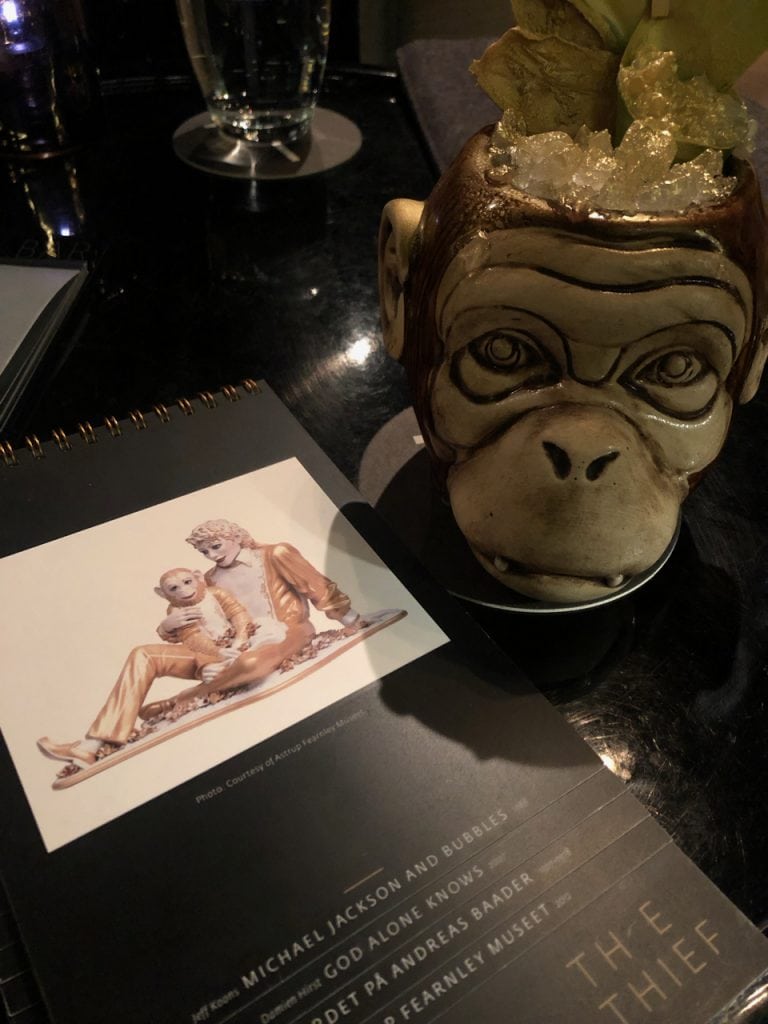
I couldn’t actually see how to drink out of it. Too embarrassed to go and get a straw, eventually I managed to get my lips around Bubbles’ cranium and have a sip.
Boy it tasted extremely alcoholic. But it wasn’t unpleasant at all! Definitely not what I’m used to drinking, but I wasn’t going to have a problem finishing it.
After a while the barman came across to check what I thought of it. I nodded my approval and said it was delicious. It was only after he walked away I felt something on the end of my nose and peeled off something large and bright pink 😩. It must have been something from the cocktail. What a minter as they say in Dundee.
Also – after sipping away for a while, I spotted a straw emerging from the back of Bubbles’ head, which I’d previously failed to notice. Where had it been hiding? The barman hadn’t come anywhere near my drink. Had I failed to spot it in between the leaves decorating the drink? Or had it been visible all the time and my two glasses of wine had taken their toll?
Either way, I used that to finish the drink off then signed for the bill before having a probably slightly slurred ‘thank you for looking after me during my stay and farewell’ chat with the barman on the way out.
I made it back up to my room, and even managed a bit of packing before climbing into bed and putting the lights out practically straight away. I was pretty sure I’d get a good night’s sleep!